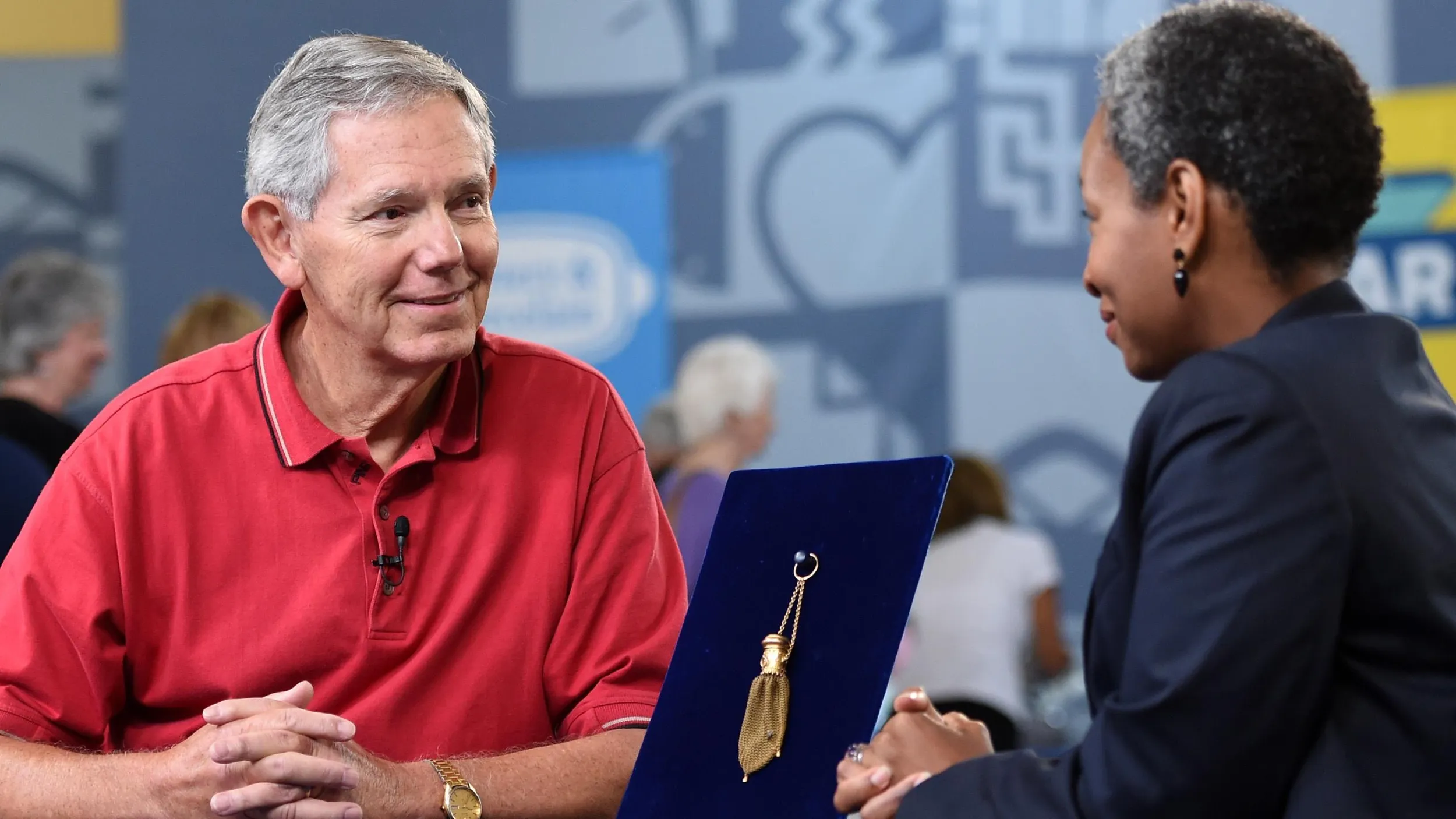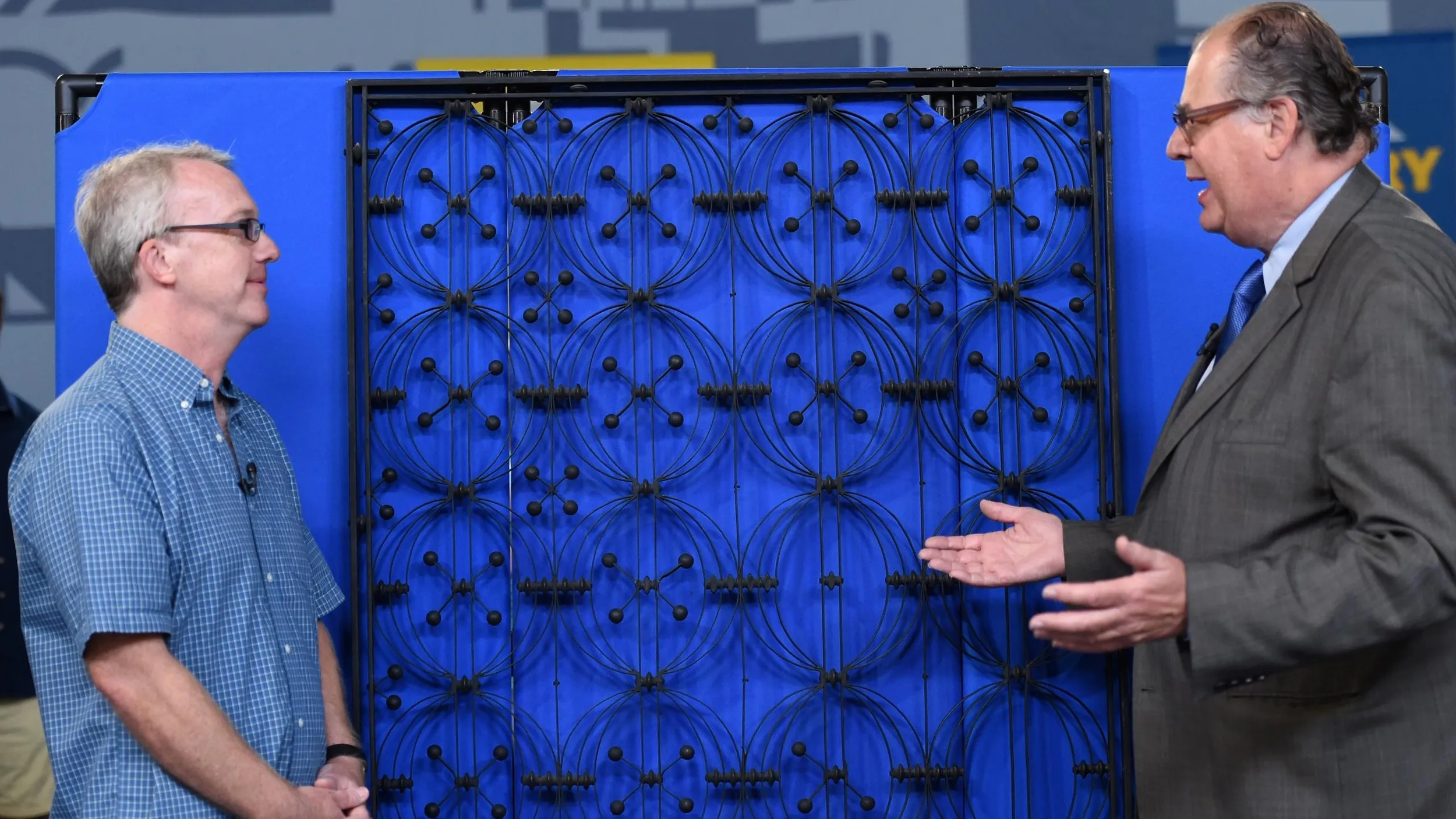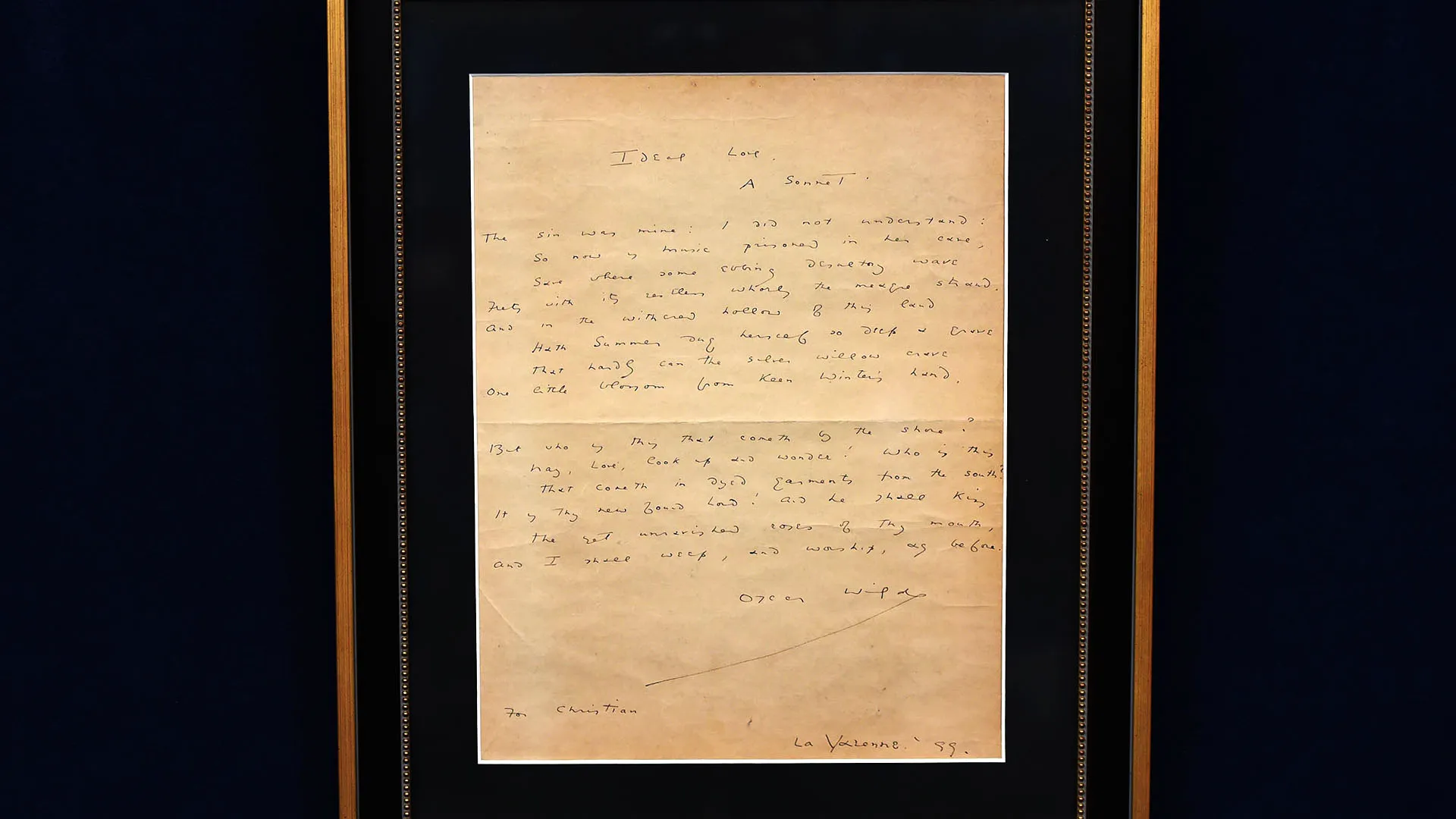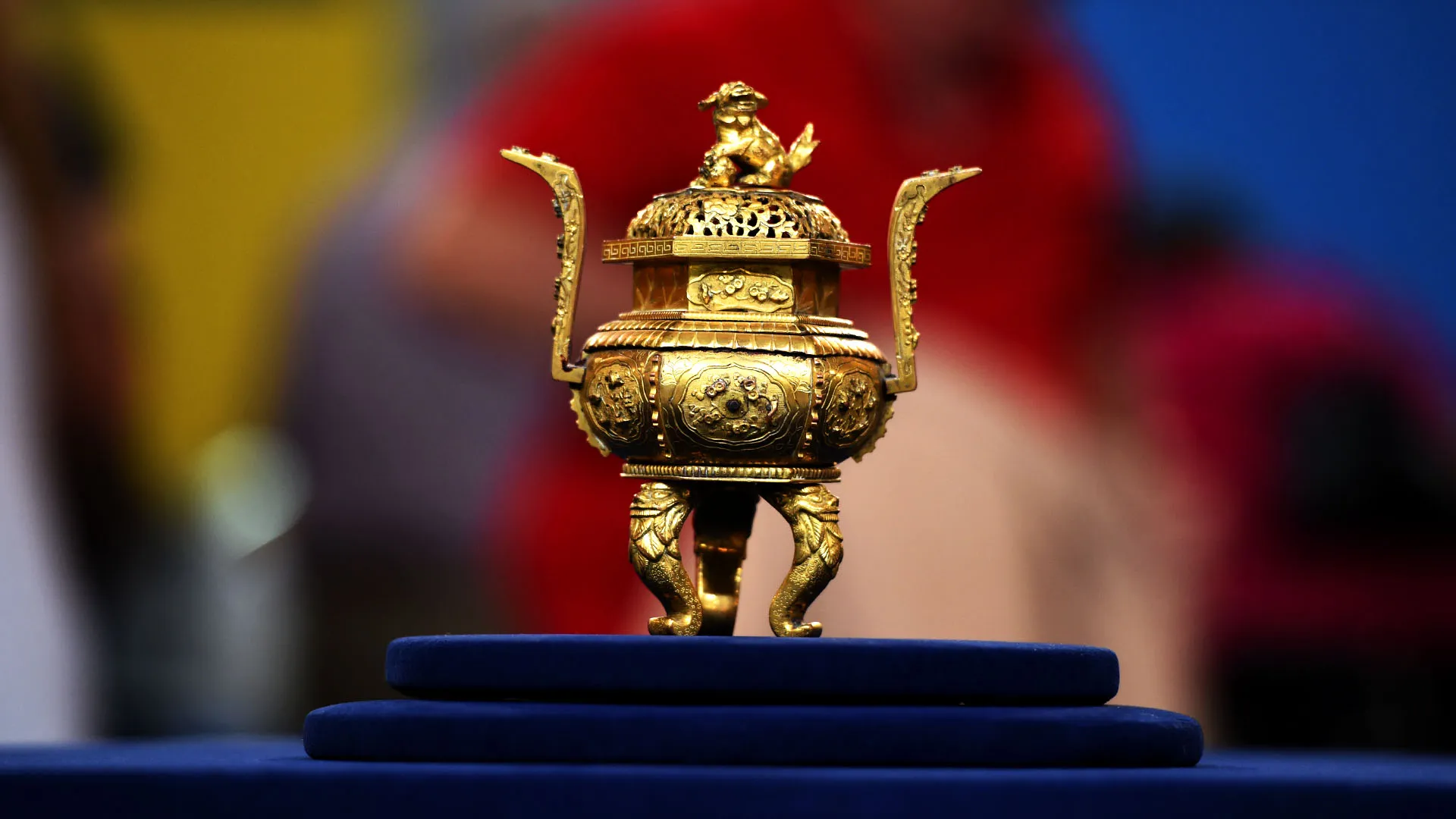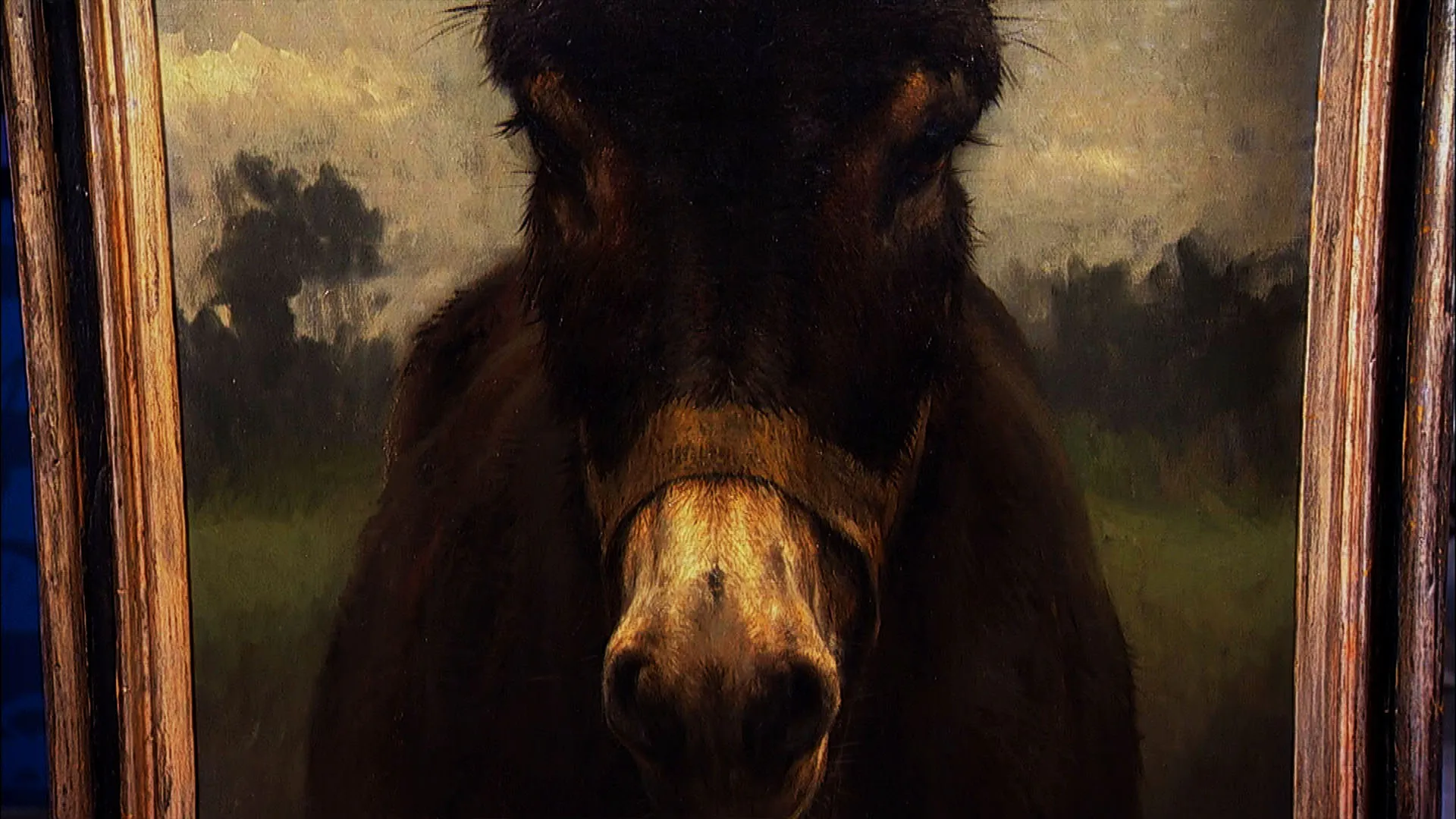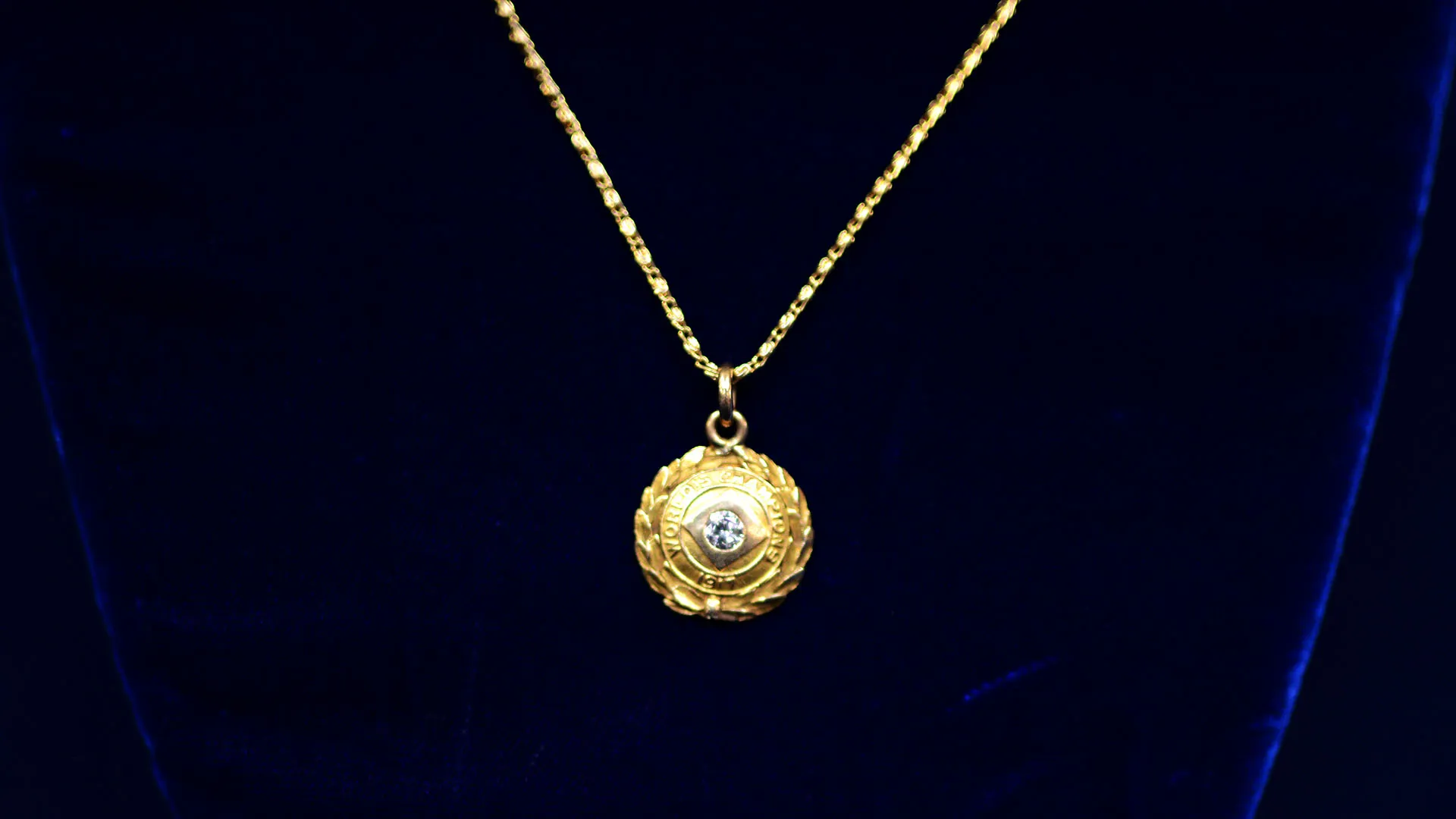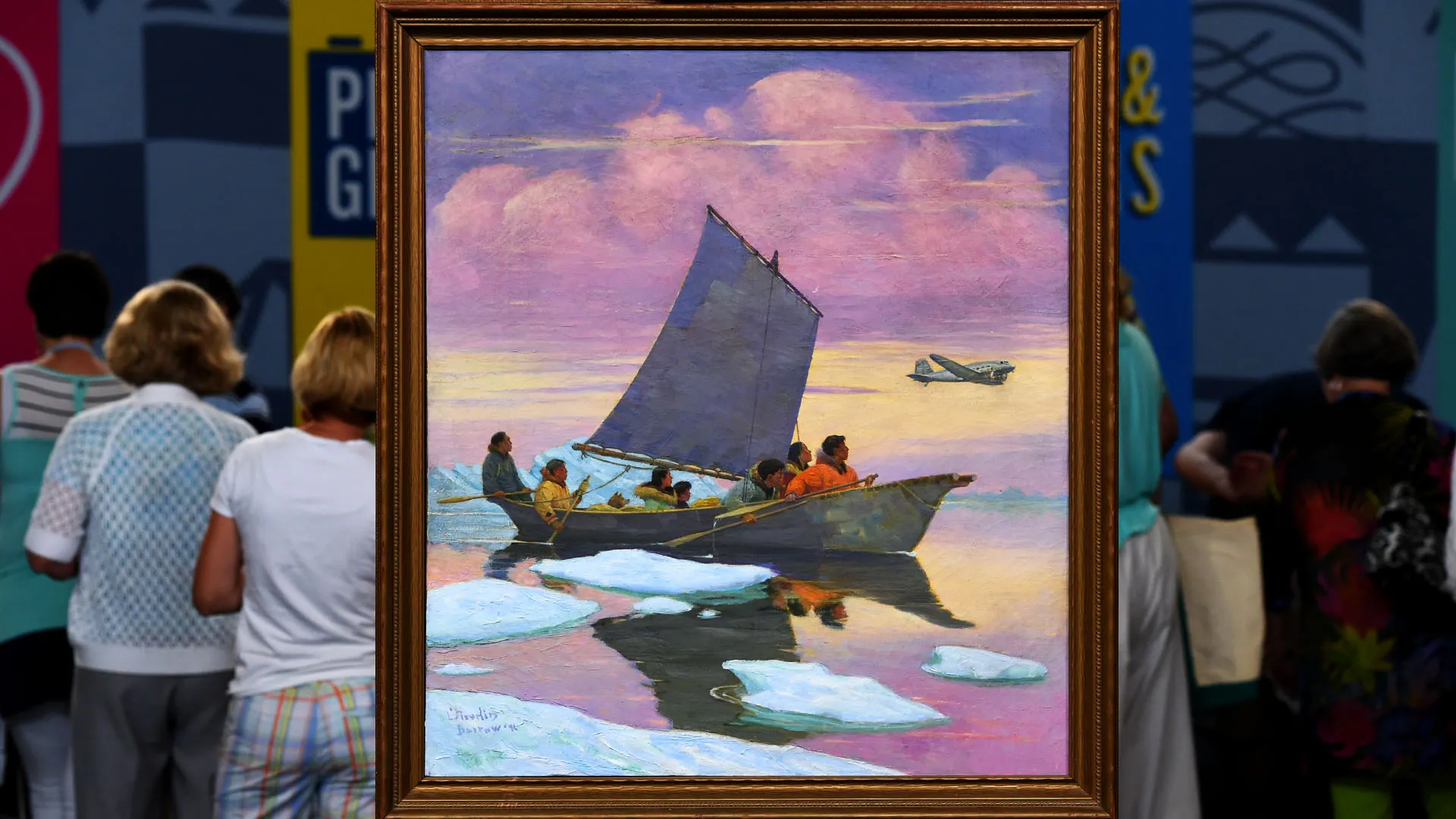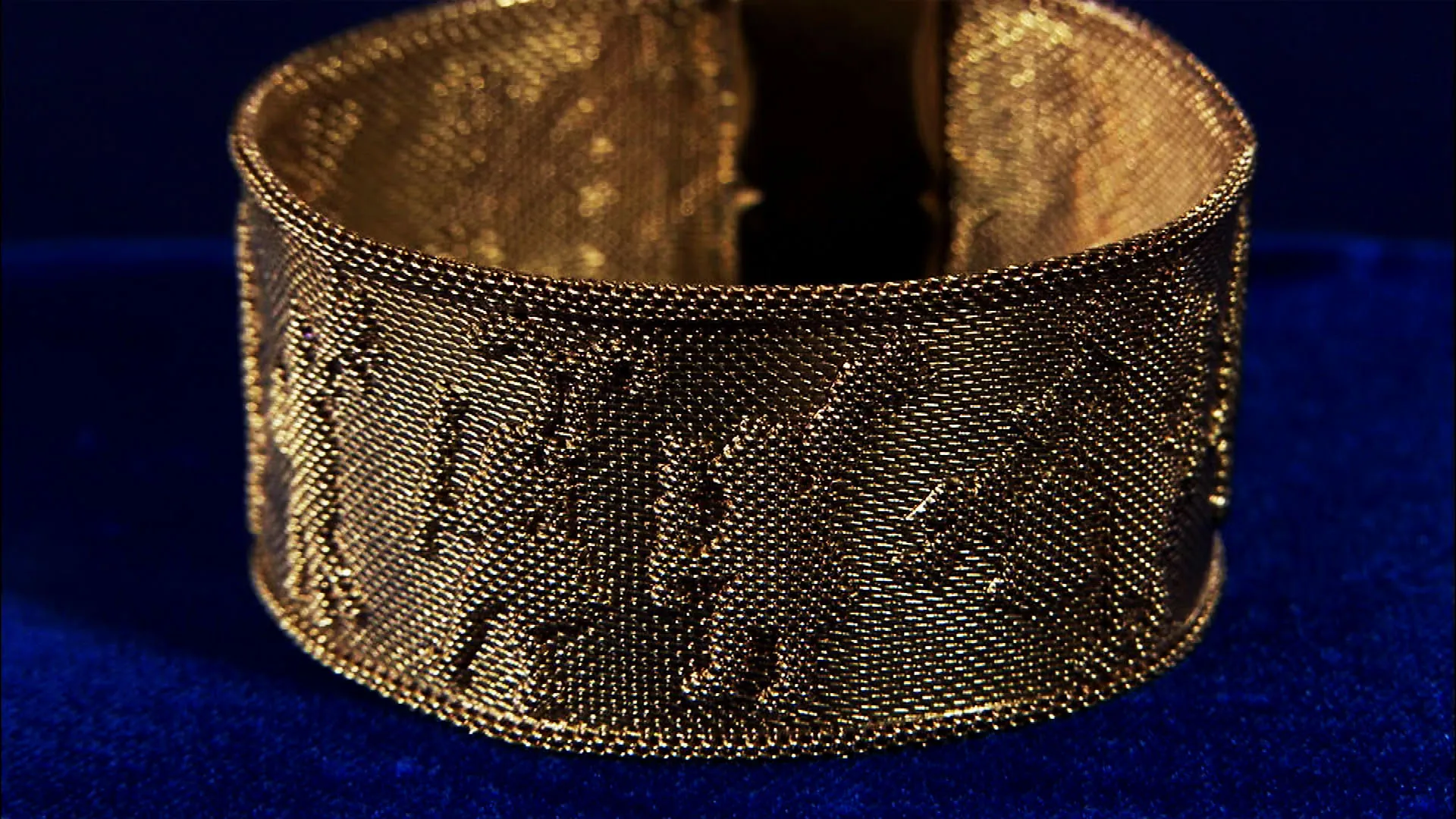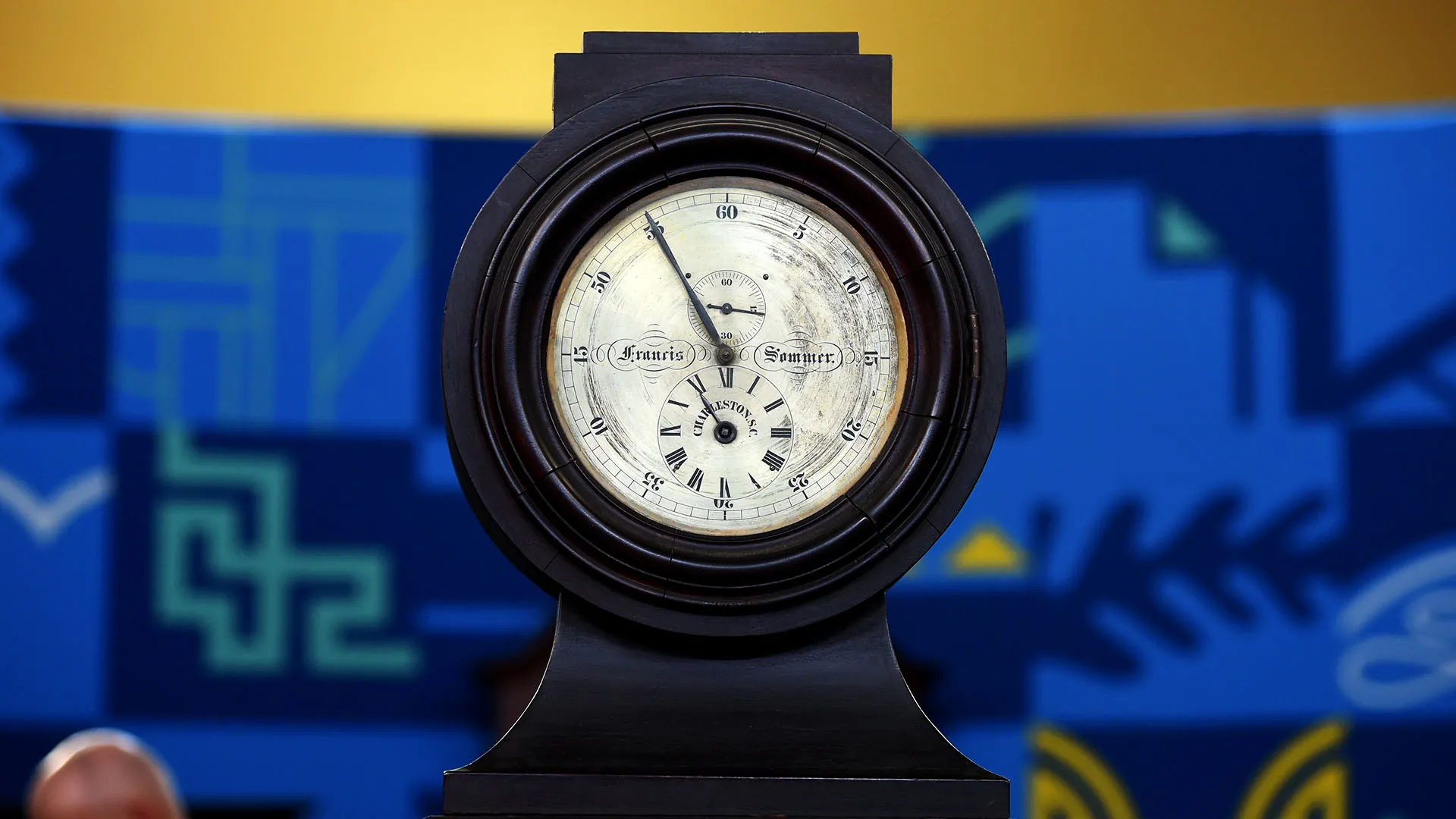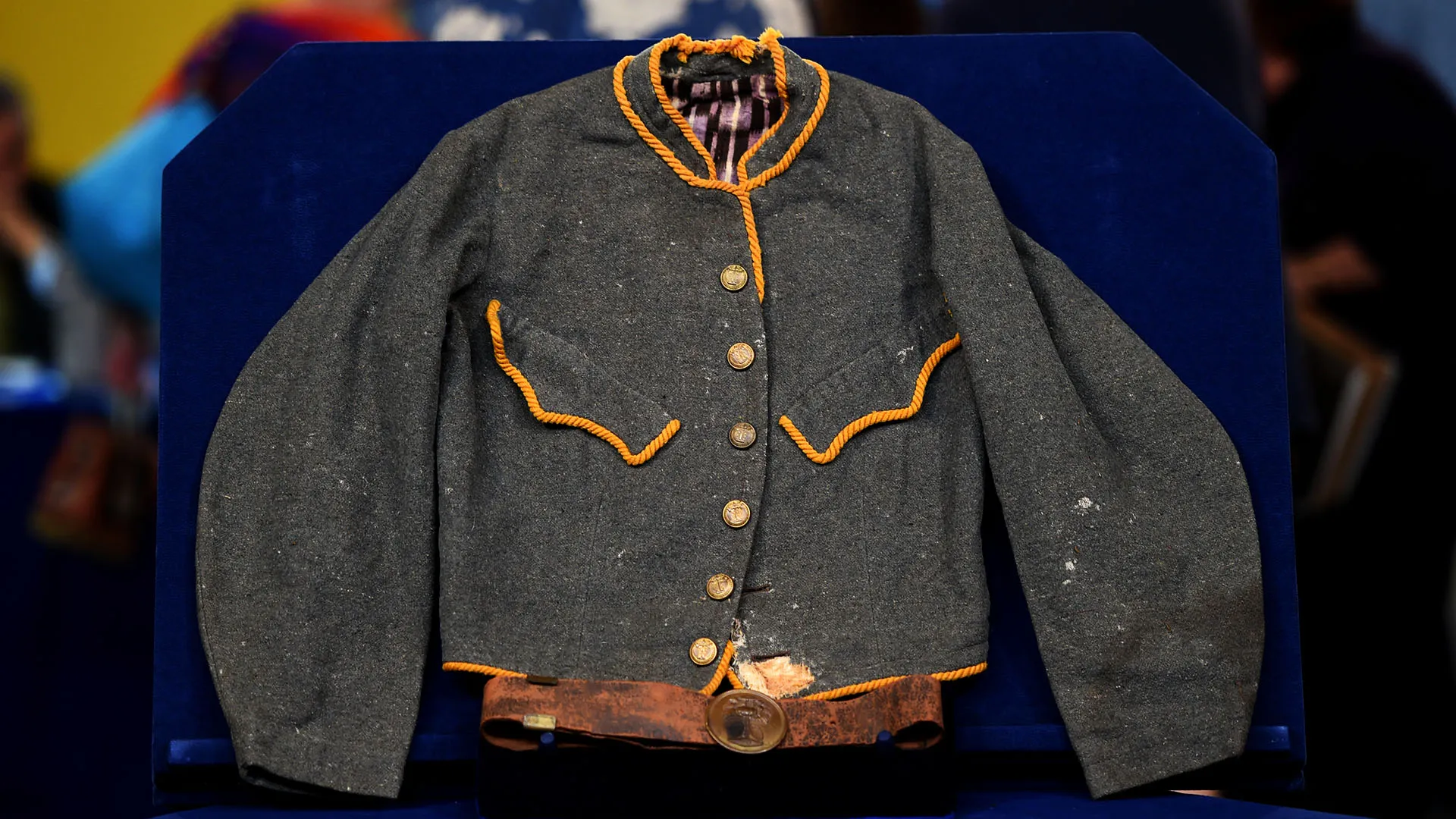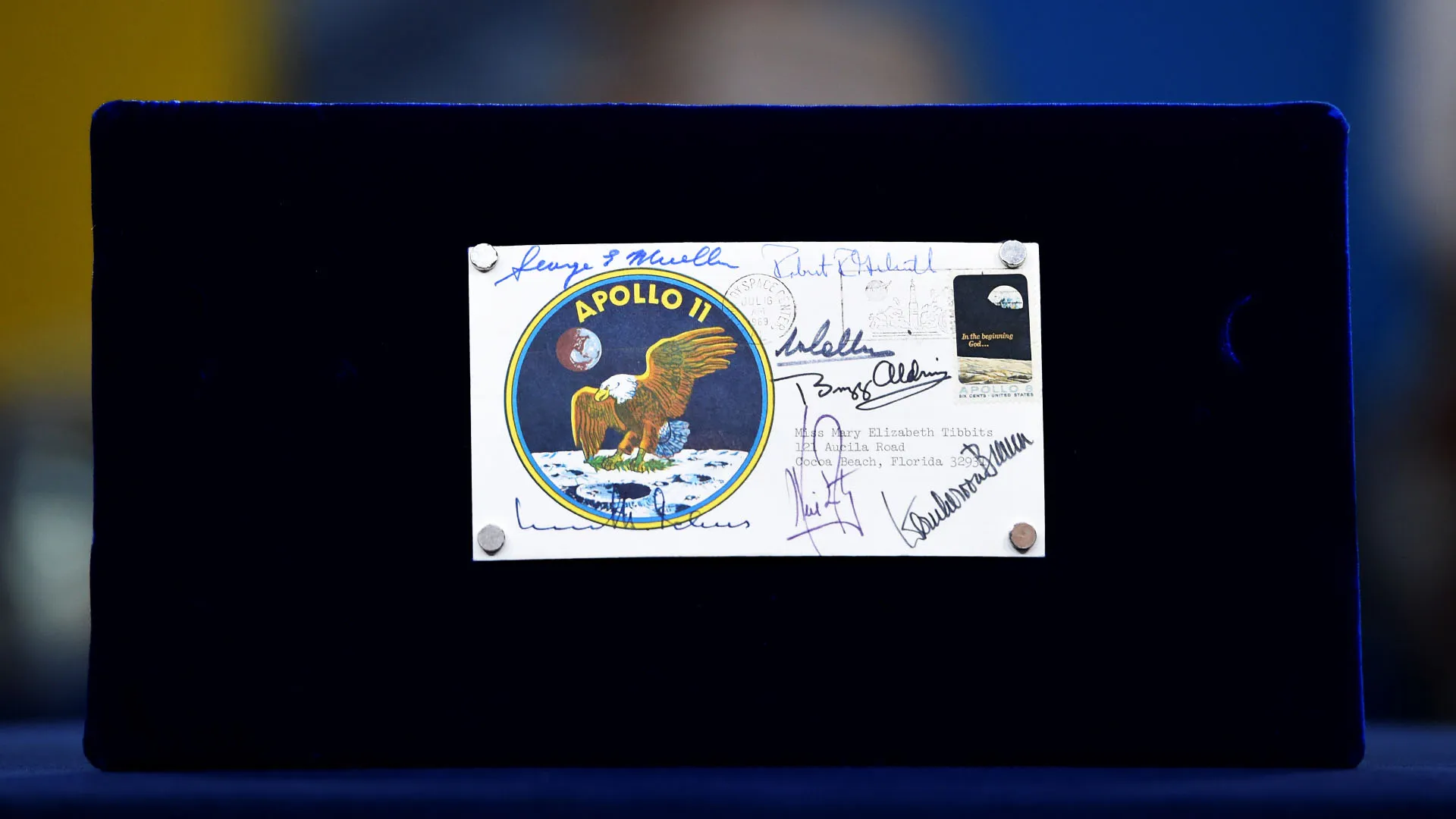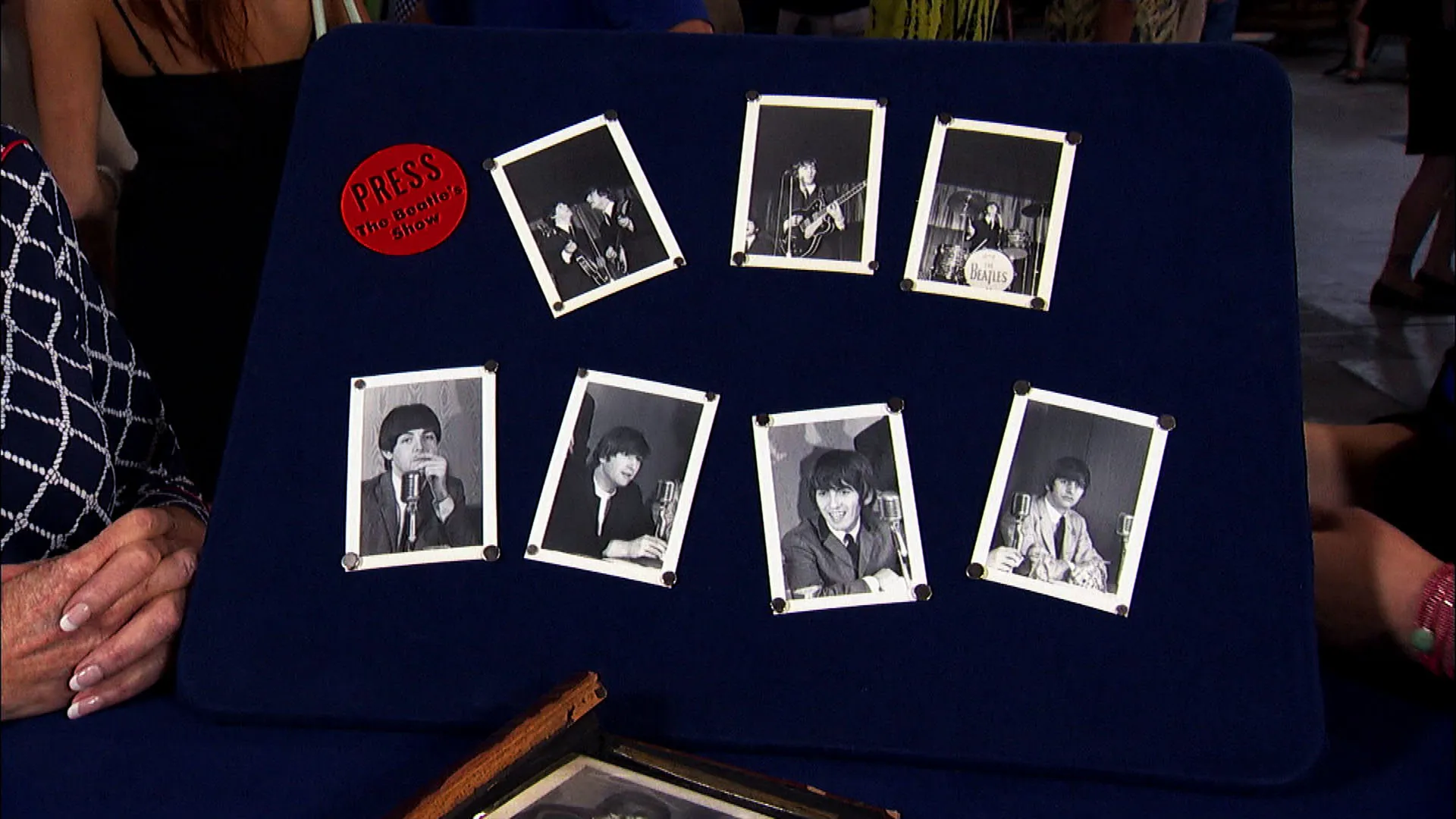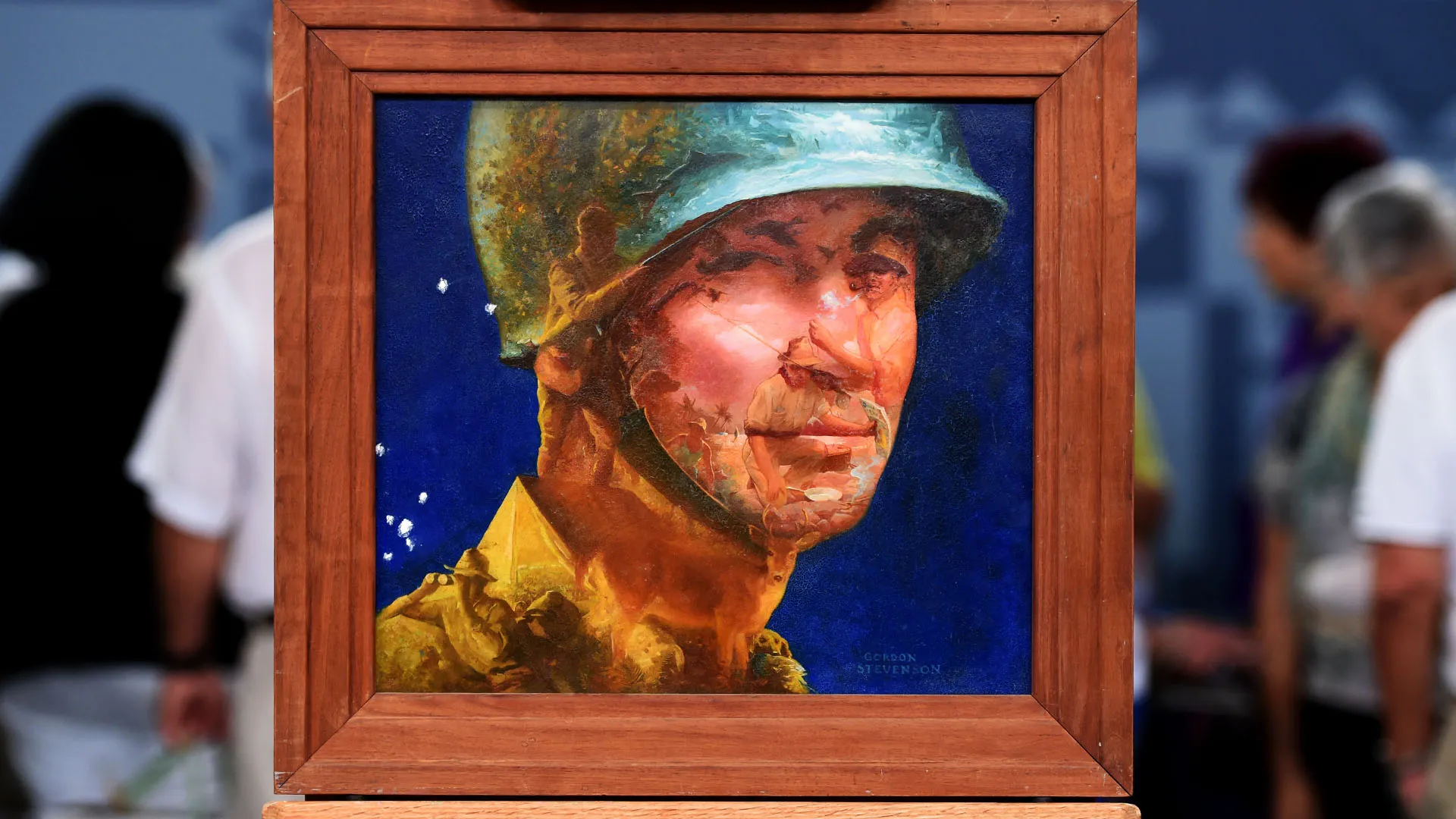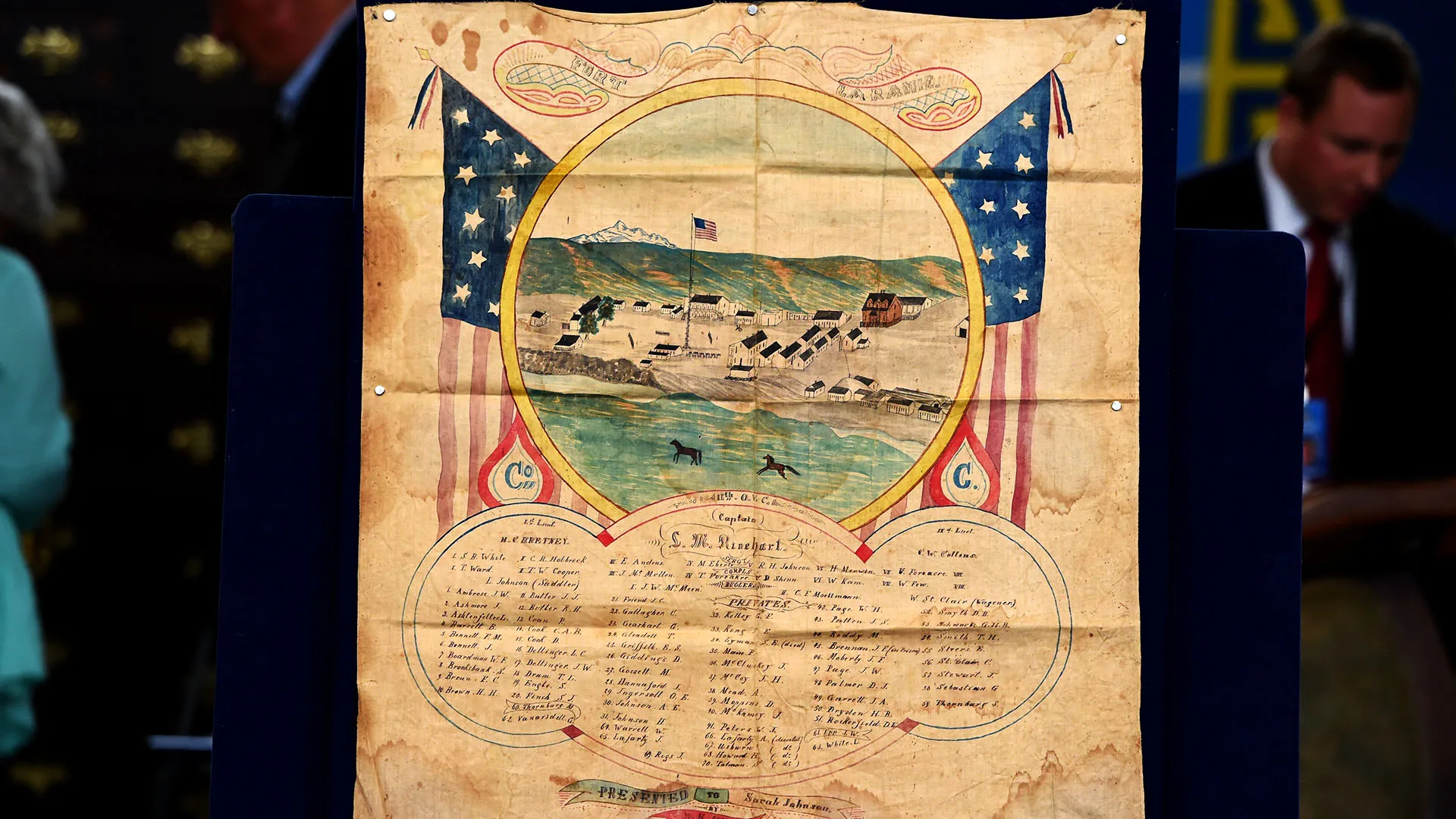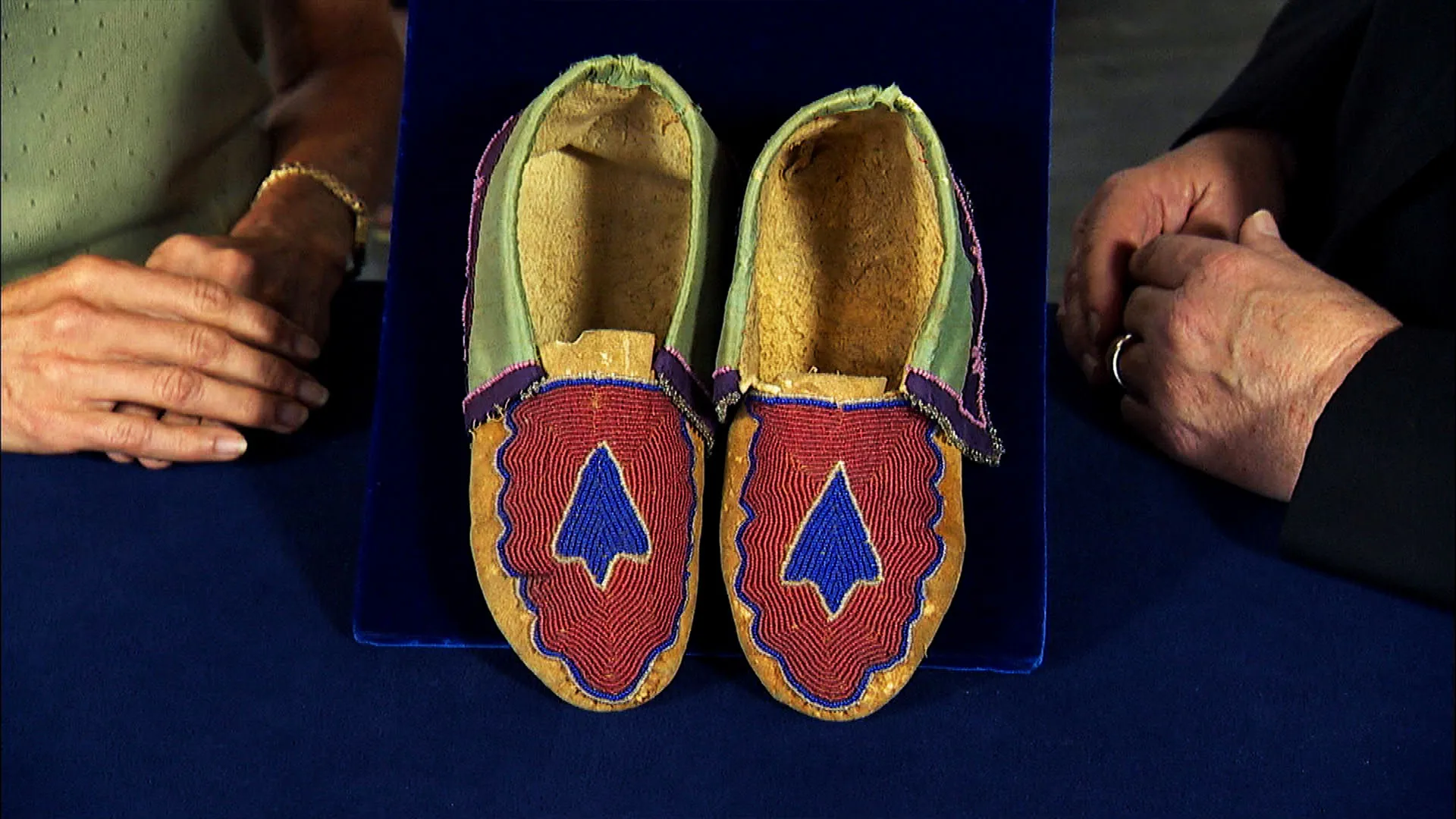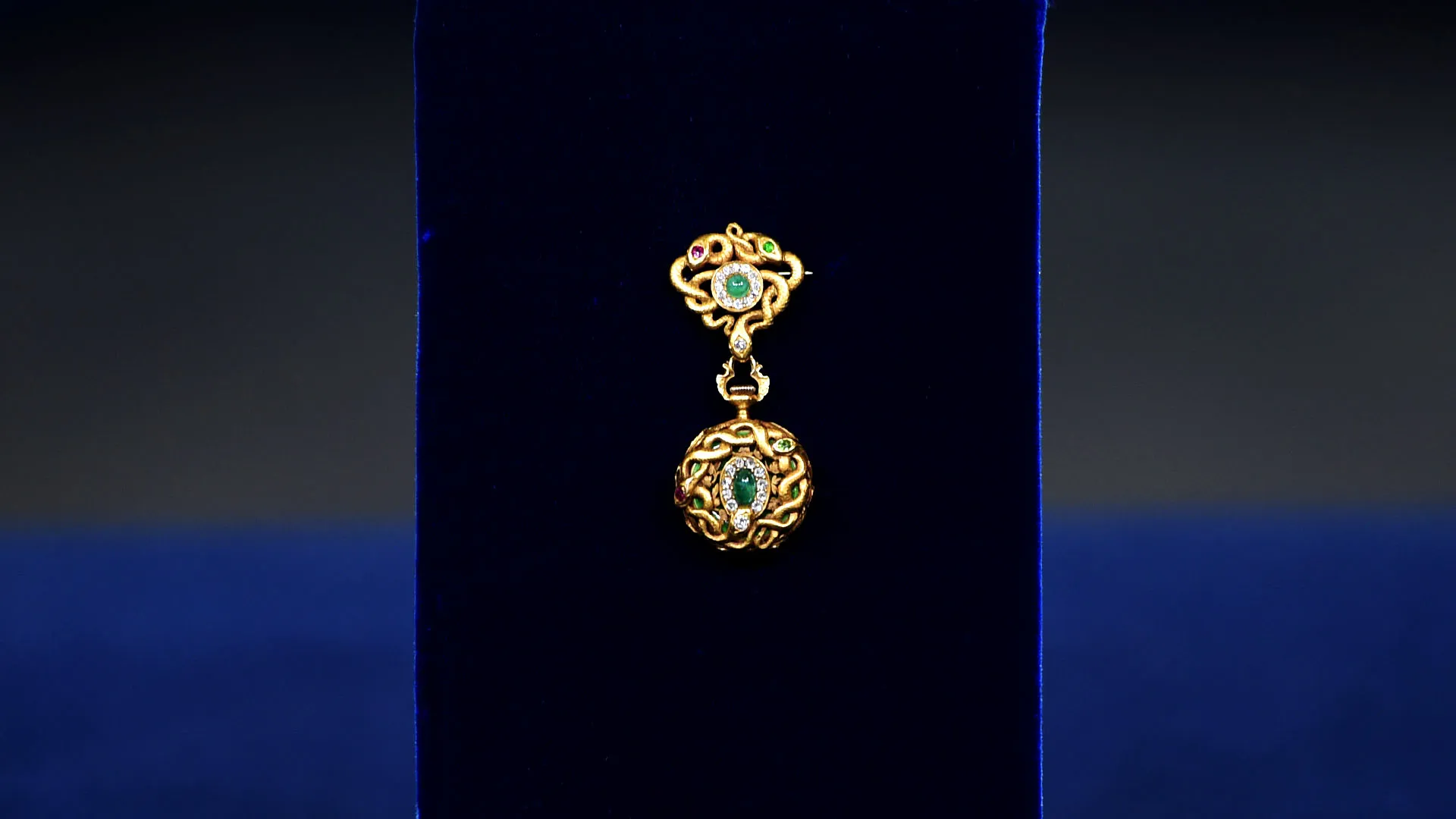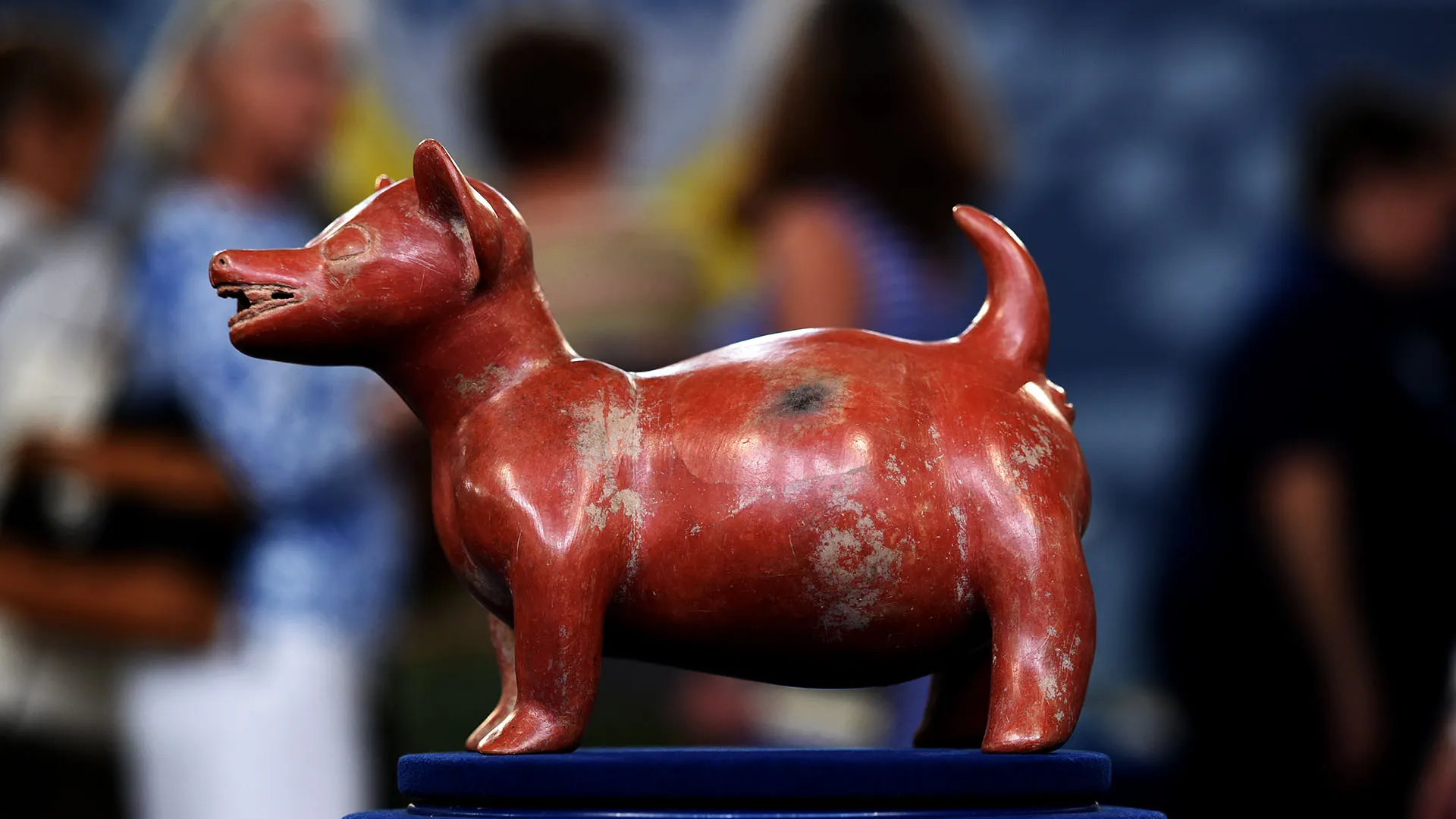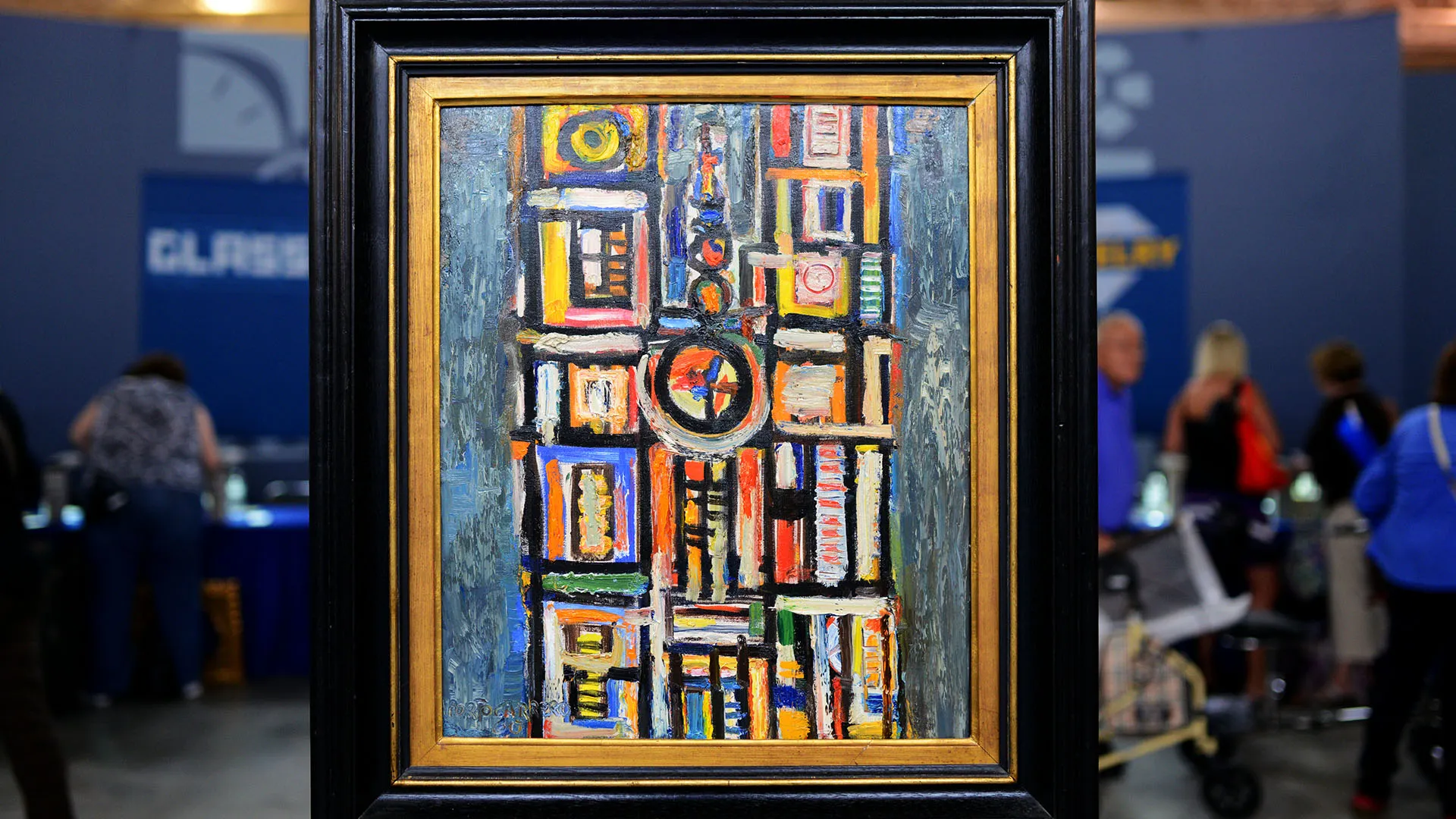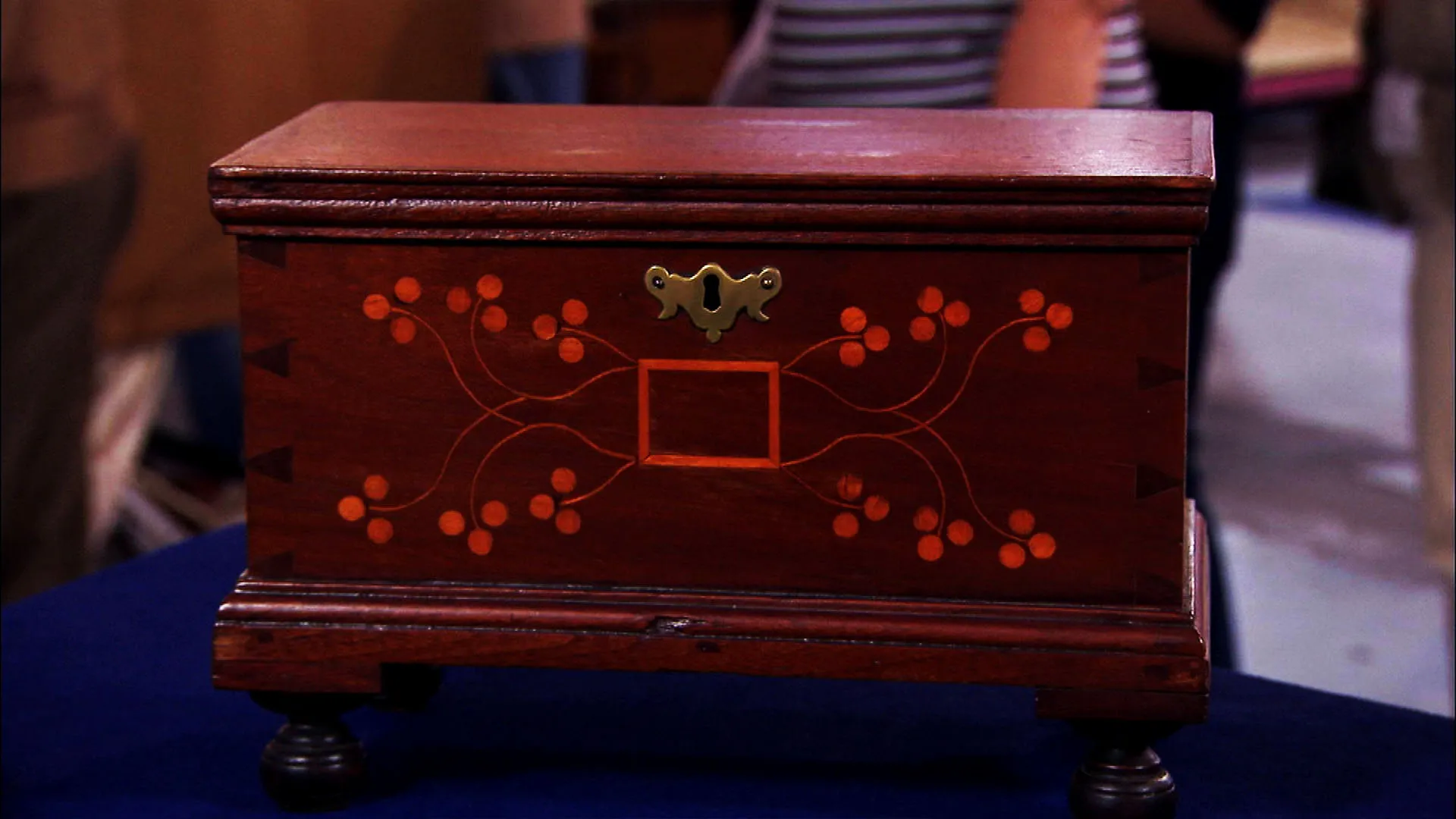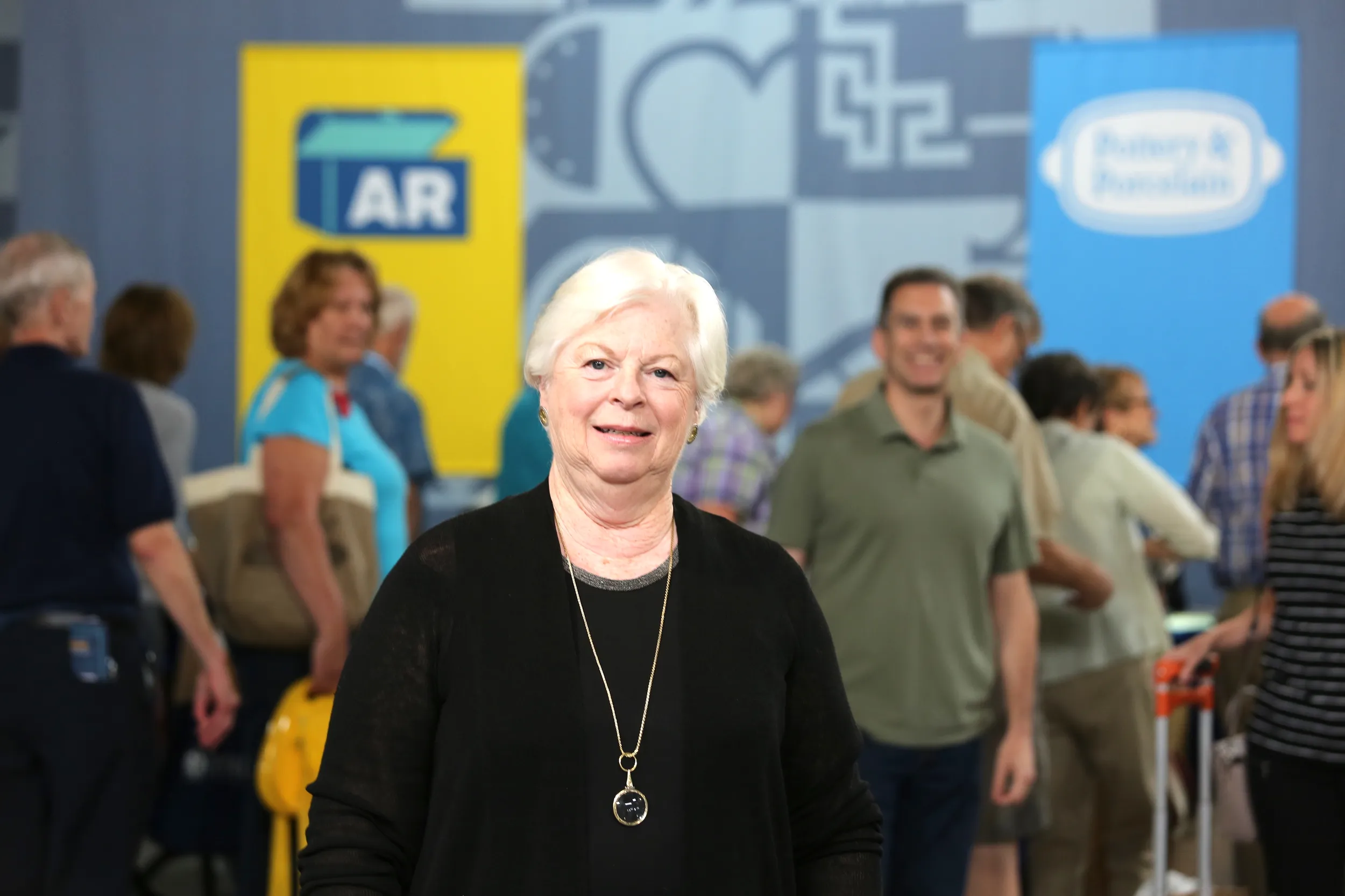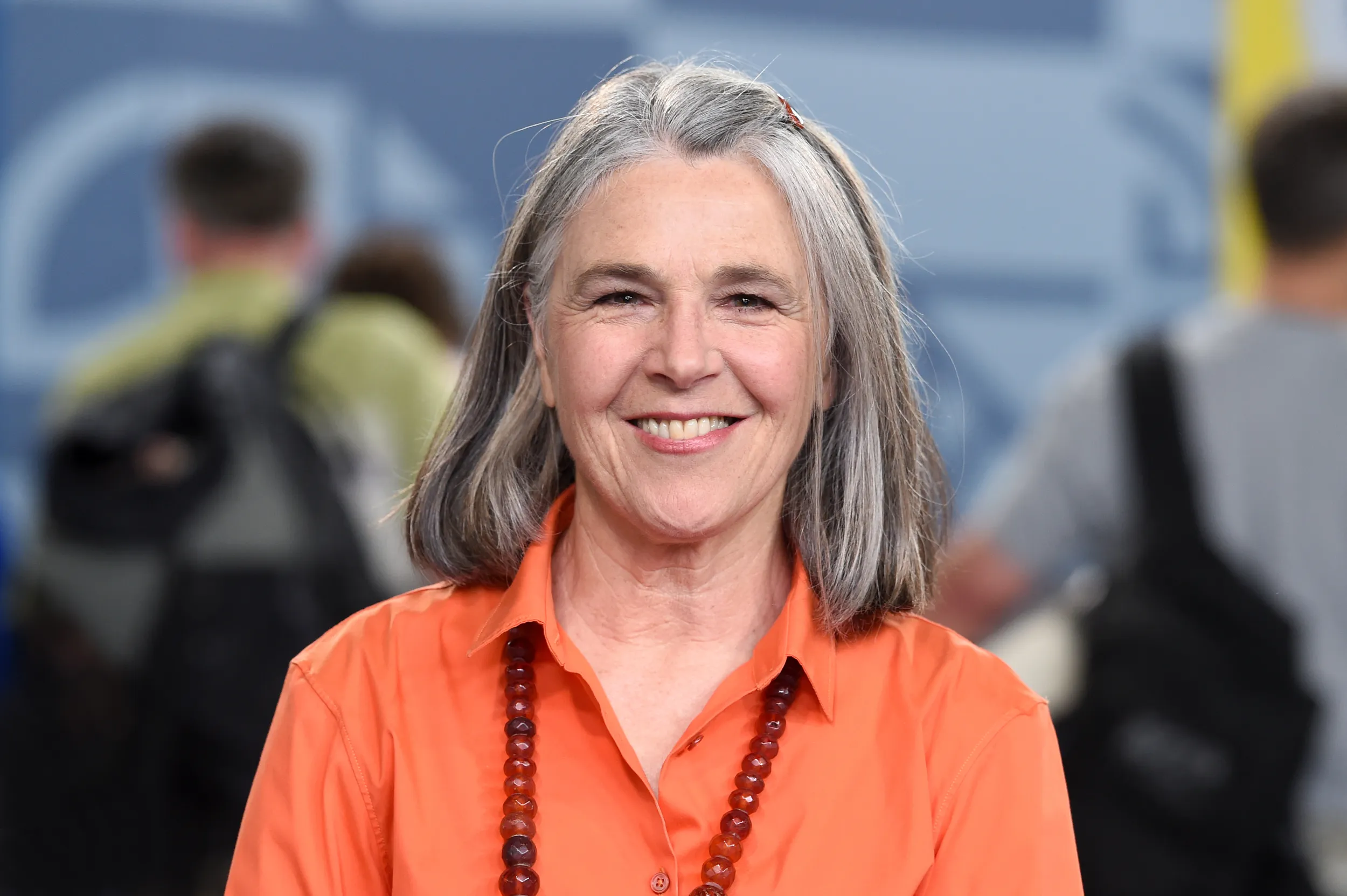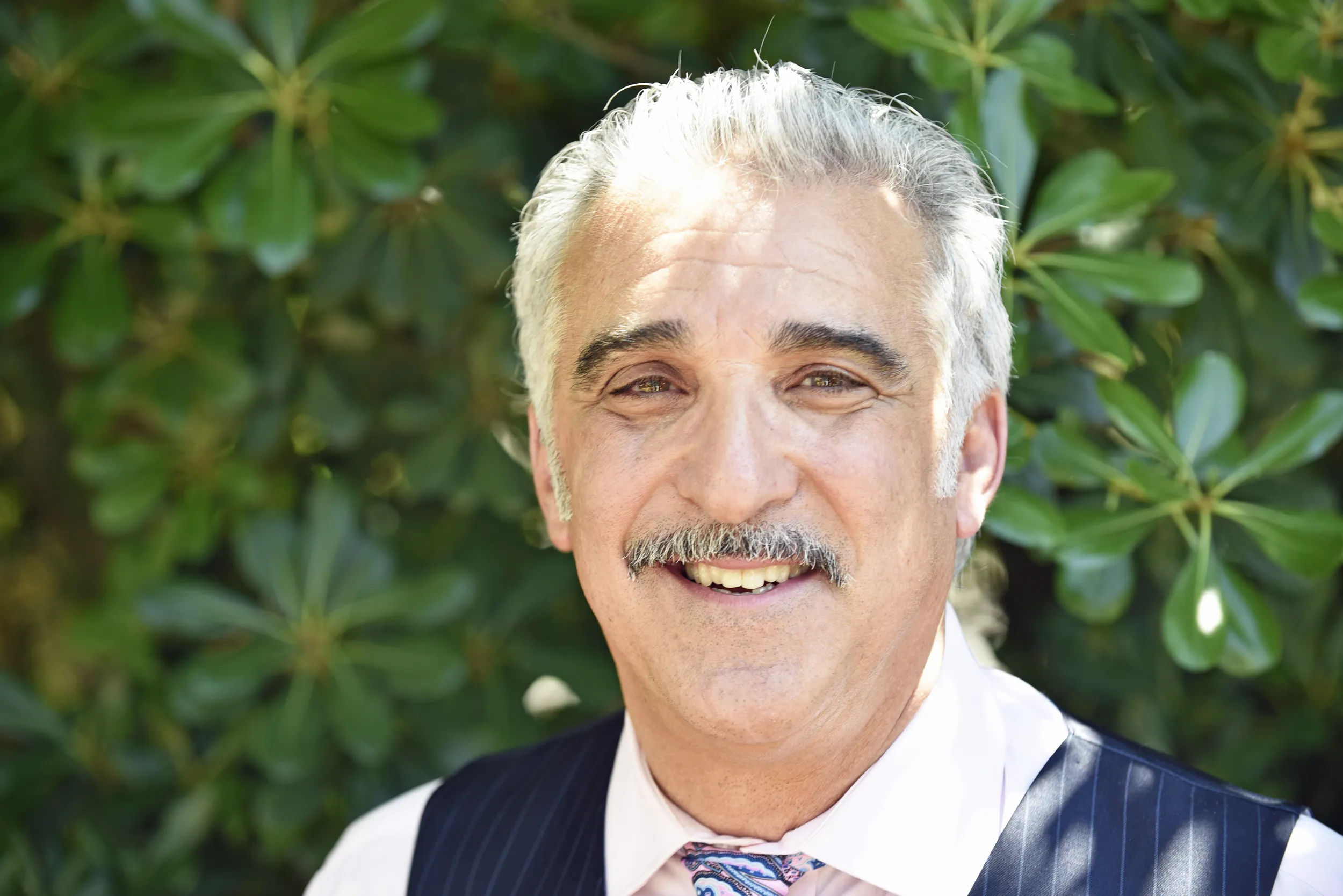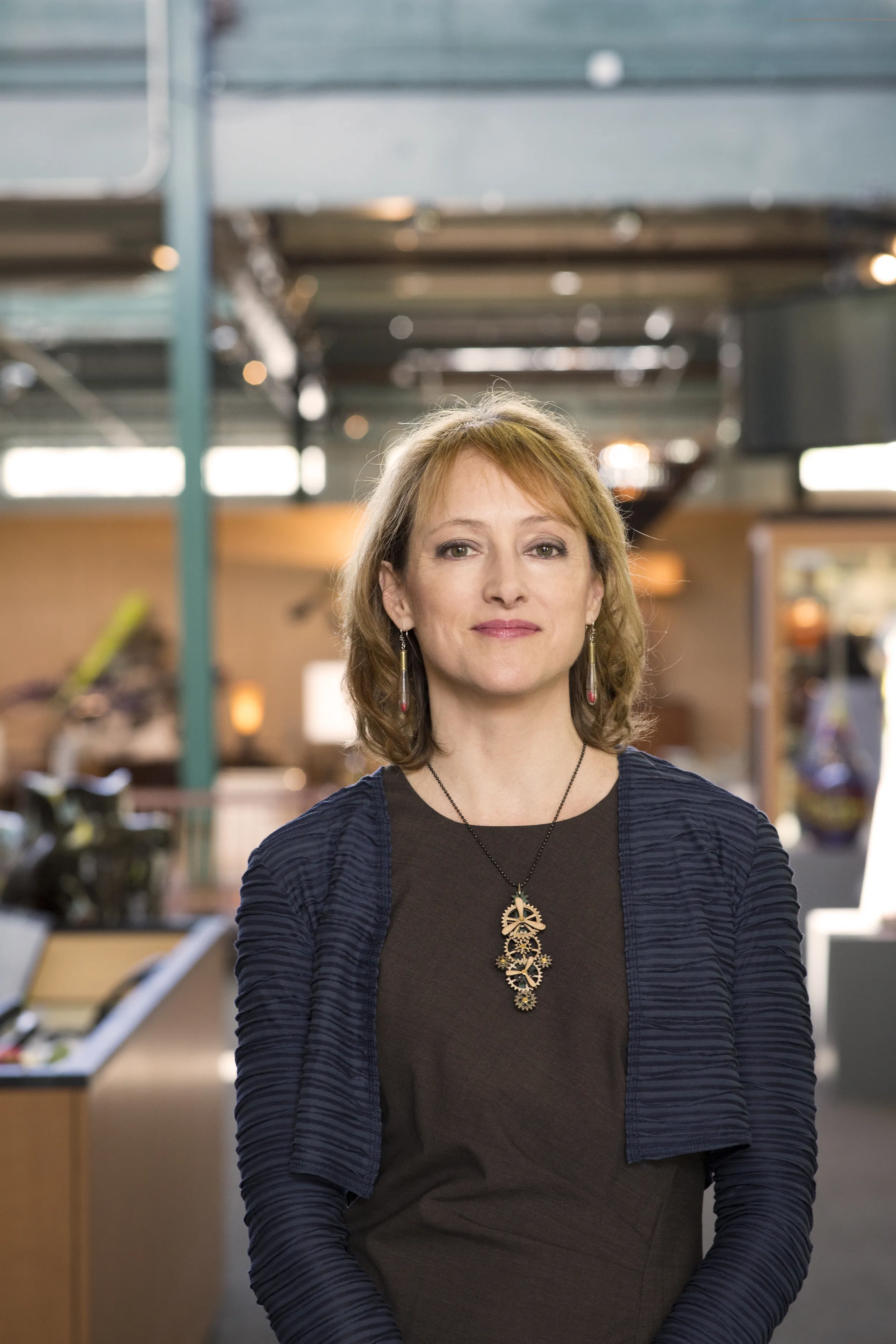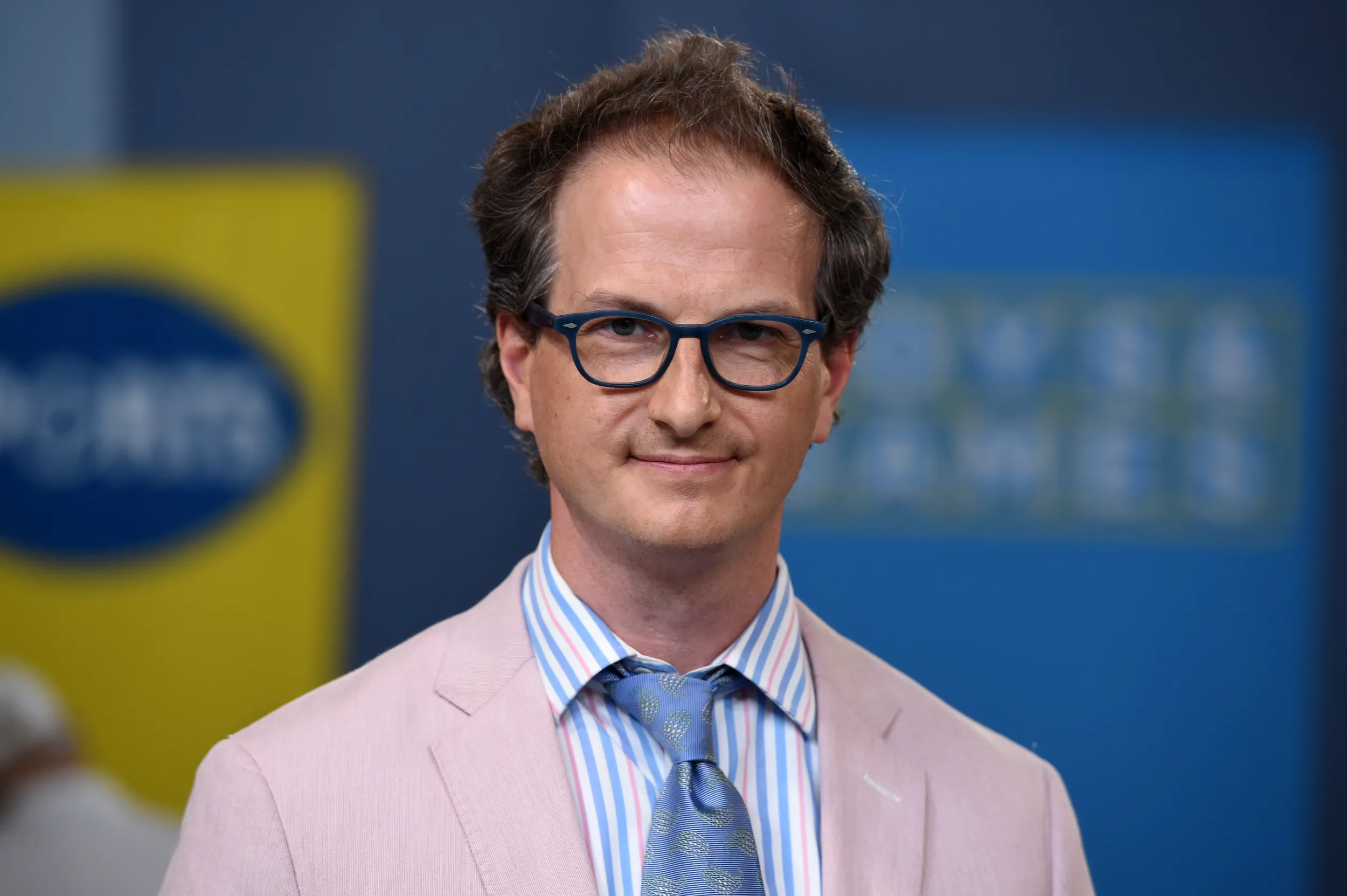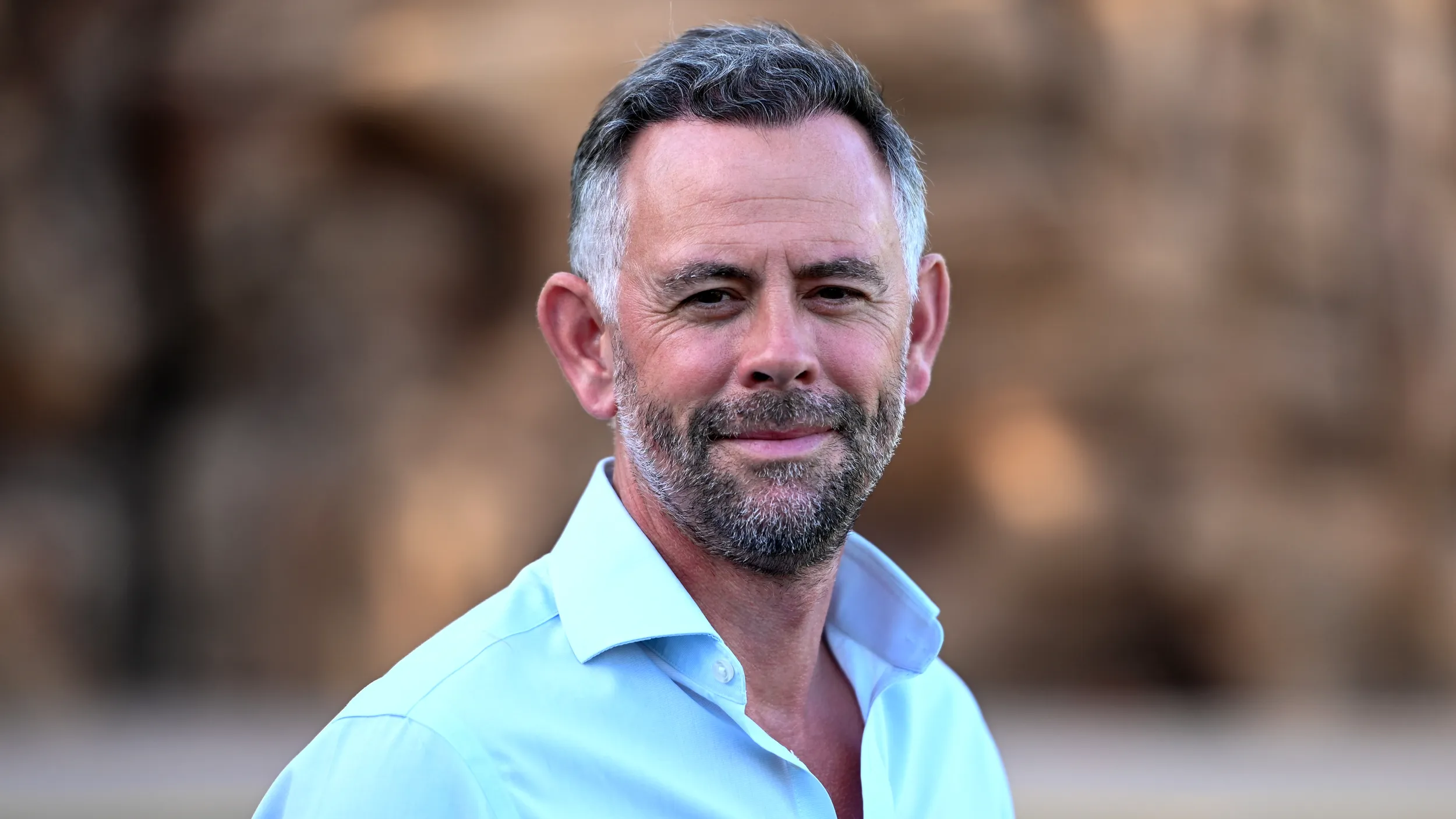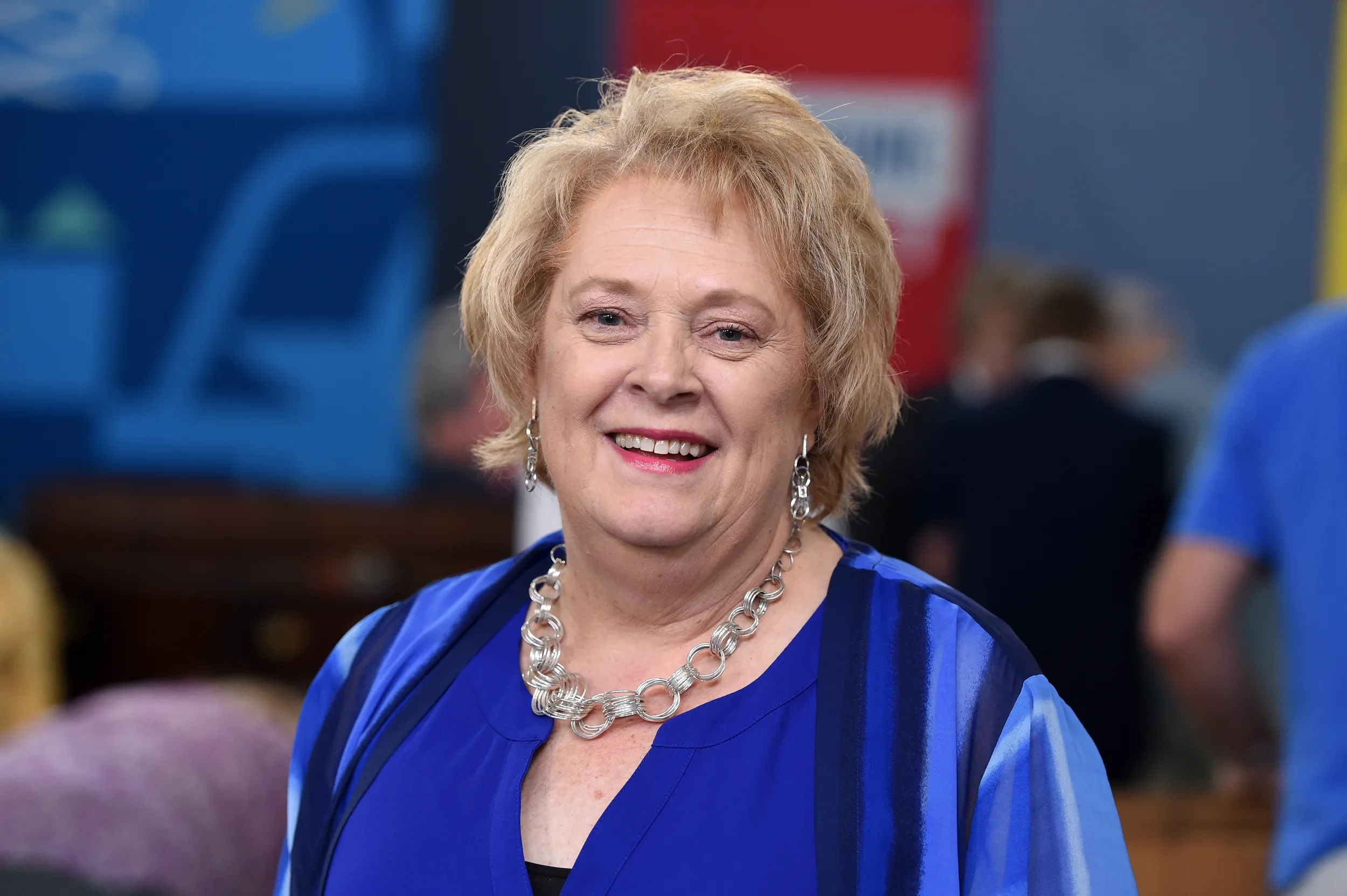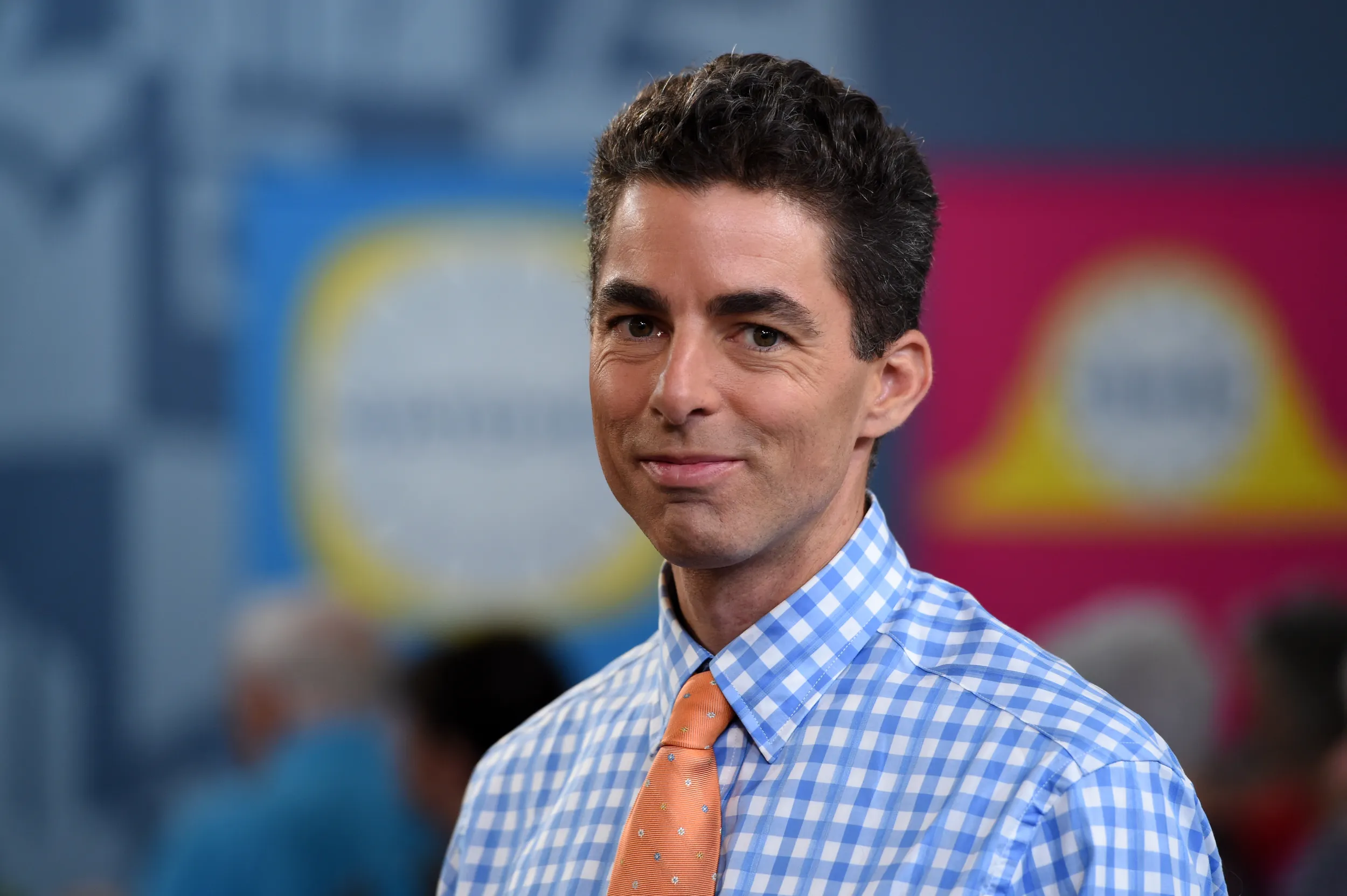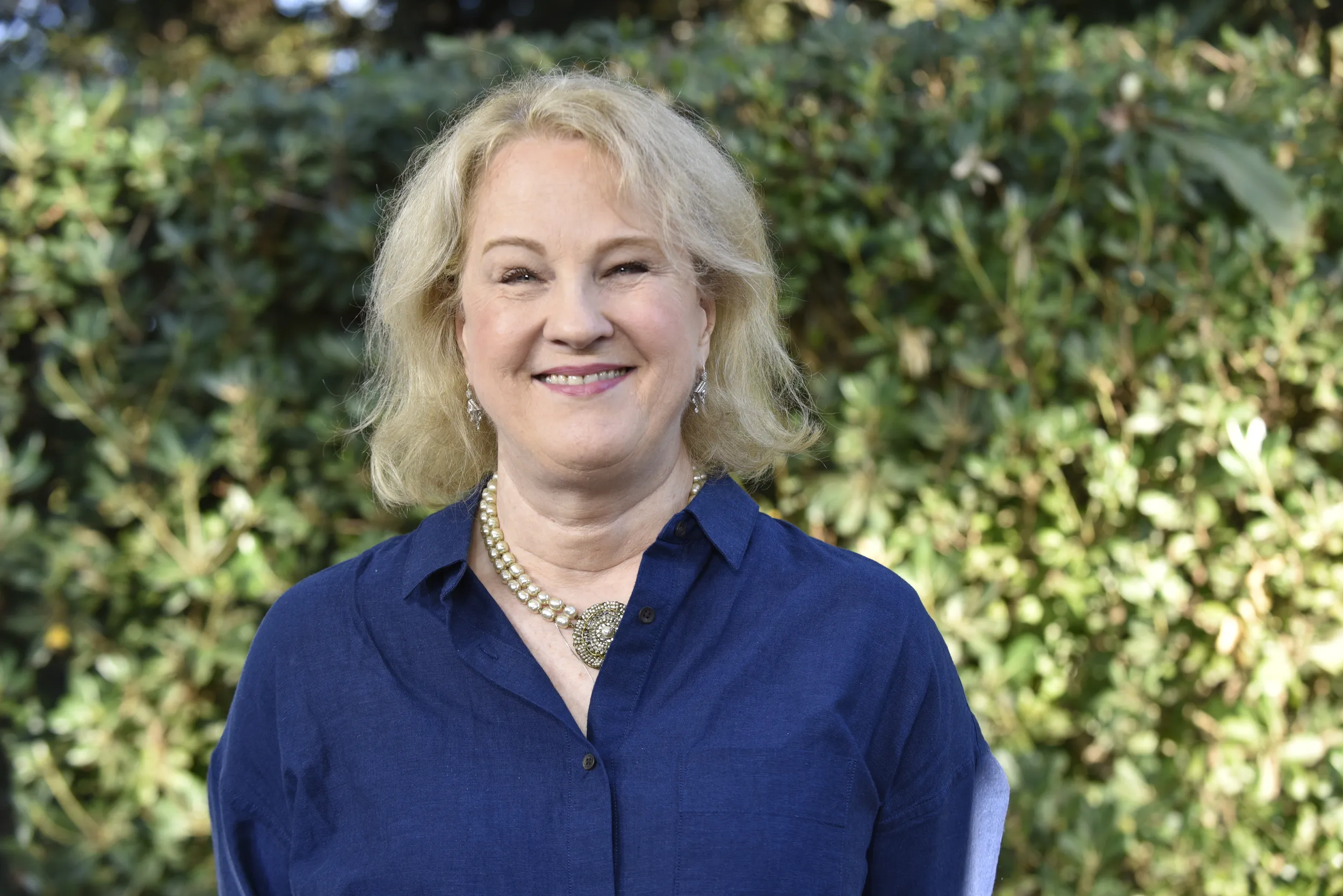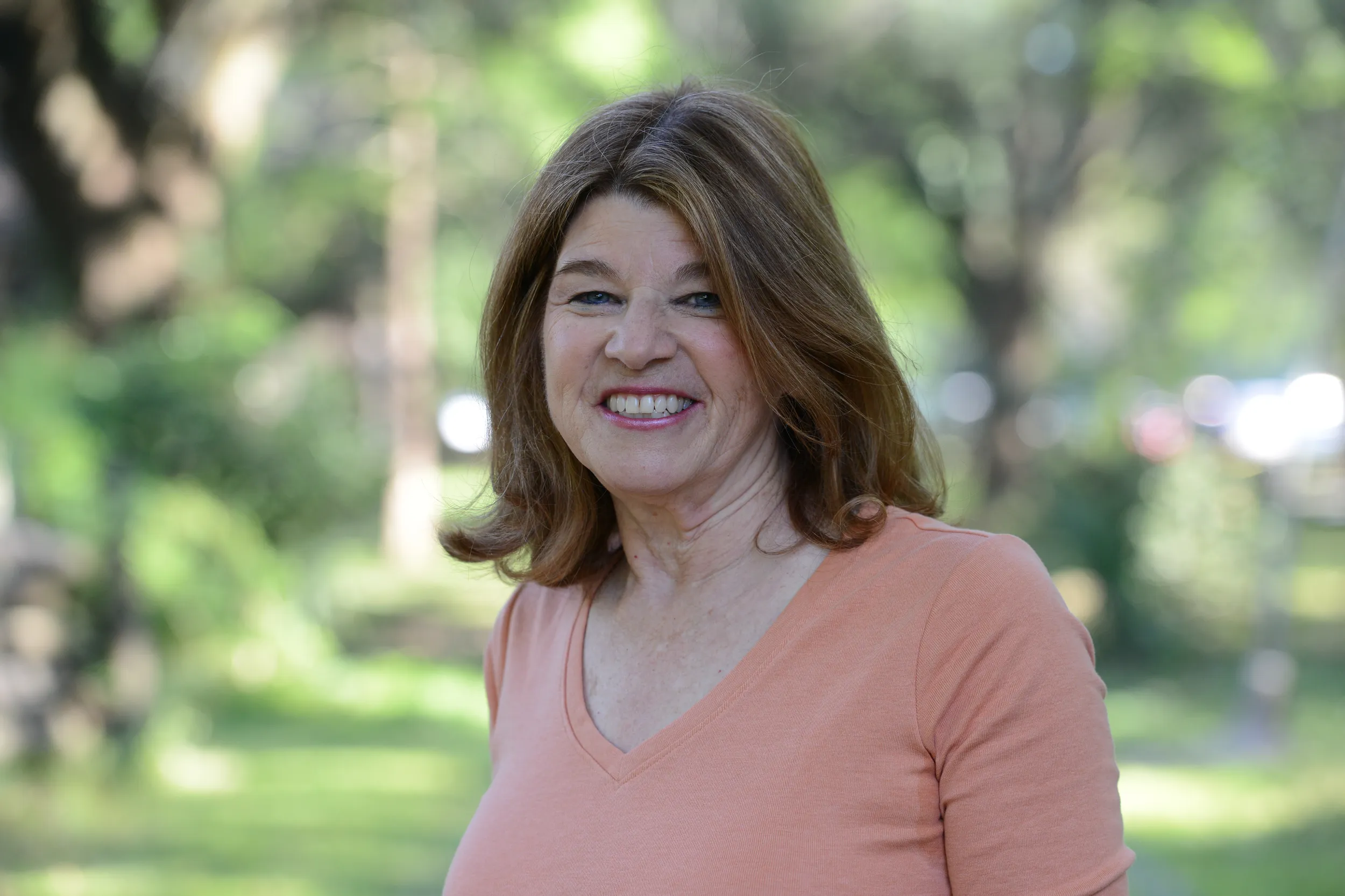HOST: Antiques Roadshow is showing off the treasures of Charleston, South Carolina.
APPRAISER: Snakes were not an evil symbol; they were a symbol of everlasting love.
GUEST: (laughing): Wow. Oh, my gosh.
GUEST: (laughs) Spot, you're doing good.
HOST: One of the things that makes Charleston such an enchanting city is its remarkable dedication to the preservation of historical places. With so many incredible 18th and 19th century homes, plantations, and important cultural sites, locals and tourists delight in experiencing what's often been called "a living museum." In 1882, Oscar Wilde, the famous Irish writer, stopped here while on his American tour. Well over a century later, we found one of his poems. Take a look.
APPRAISER: I really appreciate you bringing in this wonderful manuscript poem by Oscar Wilde today. Why don't you tell us what you know about its history?
GUEST: I worked for a woman when I was in college taking care of show dogs that she had. She approached me one day and she said, "I know you're an English major, you'd like this," and she handed it to me.
APPRAISER: Do you know much about where she would have acquired it? Was it a relative or something?
GUEST: Her father-in-law was the man referred to here as "for Christian." He was a newspaper reporter at one time in the late part of the 1800s and covered the Dreyfus trial in Paris, and that's where I believe he met Wilde.
APPRAISER: So it's inscribed on the bottom here "for Christian." As we understand, it was Christian Gauss who received the poem.
GUEST: That's right.
APPRAISER: And he became a fairly important professor and dean of the college at Princeton, wildly renowned person. But as you say, he was in Paris apparently in 1899 for the Dreyfus trial and wrote articles for The Nation, and by repute, had met Oscar Wilde. Oscar Wilde, one of the most important Irish poets of the late 19th century, playwright, wrote The Ballad of Reading Gaol and The Importance of Being Earnest, and persecuted for his homosexual lifestyle. At first, it appeared that it might have been an unpublished poem because the title here, "Ideal Love: A Sonnet," is not a title that's recorded in the literature as a poem by Wilde. But I discovered the text of the poem is actually quite a well-known and very famous poem by Wilde called "The New Remorse," which he wrote in 1891 for his lover, Lord Alfred Douglas. It's a very powerful, evocative love poem in essence, but it's layered with elements of guilt and remorse. So the first line, "The sin was mine, I did not understand. So now is music prisoned in her cave." A concealment of the homoerotic love affair he was having with Douglas. Now, this is incredibly important because eventually, he sued for libel-- Douglas's father-- and in turn was accused of gross indecency, and eventually put to trial, convicted, and he went to jail for two years of hard labor that really broke his spirit. After being released from jail, he went to Europe, reunited with Douglas, but he eventually ended up in Paris destitute, and we know very little about his time when he was in Paris. And this is essentially his last year alive. He died in 1900 at the L'Hotel in Paris basically penniless. So the fact that this was written in 1899 to Mr. Gauss at a place called La Varenne... We're not sure where that may be-- there is a hotel La Varenne. The most important thing though, I think, is that he's taken this poem he wrote for his first lover that was layered with remorse and guilt, and has renamed it, "Ideal Love: A Sonnet." It's almost as if he's reinterpreted his own words. Now, after having gone through the trial and prison, and actually at this point been separated from his lover with a new kind of positive look on the words that he had written some ten years before. So it's a fascinating piece of history. Have you ever had it researched for value or any other purpose?
GUEST: I shopped it around years ago and someone said they thought it could be worth $6,000, $5,000.
APPRAISER: Well, he did do a number of commemorative pieces for people of major poems, so they do come on the marketplace. In fact, what was purported to be the first draft of this very poem has recently sold at auction. I think this example is beautiful, I think it's in wonderful shape, and given its historic importance near the end of his life, I would put an auction estimate conservatively of $10,000 to $15,000 today.
GUEST: Great, great.
GUEST: I think it's an incense burner from the Qing dynasty.
APPRAISER: How long ago did you purchase the object?
GUEST: This past December in Hollywood, Florida, at a household sale.
APPRAISER: Have you had it recently appraised?
GUEST: I tried to look it up on the Internet, and $800 to $900 maybe.
APPRAISER: It is a Chinese gilt bronze censer. There's a pierced cover with a fu dog finial. There are cartouches to the body. These stylized handles are based in archaic bronze form, and then it's terminating on three S-shaped legs with masks to the knee. When I first saw this, I thought it was a little odd. One thing not typical of Chinese 18th century decorative arts is this punched motif. You can vaguely see a punched leaf or foliate sprig. There are some little odd characteristics as well. These lapped bands are not overly incised. Usually, it would be incised to show a lotus. These shield-shaped cartouches with the raised foliate sprigs are a little unusual for 18th century gilt bronze censers. Overall, the quality for an 18th century piece is a little sloppy, it's a little less than refined. Having said that, all of those oddities are completely consistent with where this is from in China, and that is Tonkin. Tonkin is northern Vietnam. It was part of the greater China during the Qing dynasty, and there are a few examples of metalwork coming from that region. They were particularly known for their metalwork. All of those examples I've seen in person have had patinated bronze with gilt bronze cartouches or highlights. This is the only piece I've seen that is completely gilt bronze. So for that reason, it's quite scarce. How much did you pay for it?
GUEST: I bought it along with a couple other items, a couple paintings and household goods, and I paid $1,500 for the lot.
APPRAISER: If this was a mainland China, Peking gilt bronze censer from the 18th century Qianlong period, it would be crisper, cleaner, a better example of metalwork. Its value would be around $8,000 to $10,000.
GUEST: Oh, wow.
APPRAISER: This is one of the rare times on the Antiques Roadshow I say this is a little inferior in an eye of 18th century high point decorative arts, but it's scarce, it's very scarce. So I would think in a retail setting, it's probably worth around $20,000.
GUEST: Holy cow. (laughs) That's amazing. I would not have guessed that at all. That's quite amazing.
APPRAISER: These are wonderful examples of North African metalwork.
APPRAISER: If you take the paint off of this, that's just my advice, and then you probably have a little stand that's worth between $300 and $400.
GUEST: Okay, that's not too bad for $15.
APPRAISER: $15?
GUEST: $15.
APPRAISER: I thought you told me $50.
GUEST: $15.
APPRAISER: All right, even better.
GUEST: Well, this picture belonged to my great-aunt, and it was passed down to my mother, and I've had it in my house ever since then. I think it's by Rosa Bonheur. I had done a little reading and I think she was... got in trouble for wearing pants back in the 1800s.
APPRAISER: She didn't just wear pants; she wore working man's jackets, she had short hair, and she would go around smoking cigarettes and cigars and pipes. It's signed down here with the initials "R.B.," and she was primarily known as an animal painter. She also did some sculpture, and she was best known for doing horses. Although Rosa Bonheur did not date her paintings, this is probably from the second half of the 19th century. This is a very unusual perspective to have the donkey's face so in your face, so to speak. I think if you were going to sell it at auction, it would be something like $10,000 to $15,000.
GUEST: Oh, wow, that's great.
APPRAISER: I see that here you have your grandfather with baseball uniforms here. Relief pitcher. And I see him also smiling over here, and it appears he's a dentist.
GUEST: Being a dentist was not a good thing if you were a grandkid, because...
APPRAISER: Did he ever work on you?
GUEST: Oh, yes. He used to get accused of being able to doctor a ball. Some people even said he could break the stitches to make it do certain things. So those are the hands that were going into your mouth and pulling teeth or drilling teeth.
APPRAISER: So we have Dave Danforth. What was he like?
GUEST: Dave was... and we all called him Dave, he was never "Grandfather" to any one of the many grandchildren. He enjoyed life, he never quite grew up even after he finished playing ball. Between walking between his office and his home, there was an elementary school with a sand lot, and he would almost every day stop and hit balls to kids and coach them a little bit.
APPRAISER: Did you ever throw with him?
GUEST: Yeah, oh yeah.
APPRAISER: This is your grandfather with his Chicago White Sox uniform and bat. And this is a 1917 World Series medallion. Tell us about his career with the White Sox.
GUEST: Well, you know, I haven't found a whole lot about it. I think he only pitched one game during that series.
APPRAISER: So your grandfather, Dave Danforth, was one of the first relief pitchers.
GUEST: Yes.
APPRAISER: Usually, pitchers started and completed their games. It's not like today where you have pitchers that come in in the sixth or seventh or eighth or ninth innings. And he pitched primarily for the White Sox from 1915 through 1919, when he was traded. And you mention this sort of shine ball that he created. In 1920, spit ballers and trick pitches were made illegal, but in the teens, it was the Wild West in pitching. Oh, yeah, yeah. So the story is that he would rub rosin on his legs and he would rub the ball, scuff it up so it would do crazy things. I think the Sporting News called it the "new-fangled mystery ball."
GUEST: Yeah, yeah.
APPRAISER: And his career took off. It created a lot of controversy for him after 1920, but he had a great career. His best year was 1917. He was 11 and six, he was a phenomenal relief pitcher, he was a big reason why the Chicago White Sox went 100 and 54. It was the only time in history that the White Sox have had a 100-win season as of 2015. In that year, they won the World Series. They beat the Giants four games to two. Today, they have these big honking ginormous rings. In those days, you would get a pin, or you might get a watch fob, or you could get a medallion. This is a quarter-carat diamond, and you'll see on the back his name, and it's marked "14K." Now, have you ever had this appraised?
GUEST: I had it appraised once probably 15 years ago. They said, "Insure it for at least $15,000."
APPRAISER: I would put an auction estimate of probably $40,000 to $60,000 on it today.
GUEST: (laughing): You're kidding. Wow.
APPRAISER: And I would insure it for $75,000 at least.
GUEST: Really? Now it's going back in the safe deposit box for sure.
GUEST: This was a piece that was made by my grandmother, who lived in Grand Forks, North Dakota, and this was done during the 1930s.
APPRAISER: This is Maria Martinez. She was a Pueblo artist from New Mexico. She was a favorite of my grandmother's. Do you think your grandmother ever met Maria?
GUEST: She may have. I rather doubt it. I probably would have a picture if she did. I just know that it was someone she greatly admired.
APPRAISER: I have seen a lot of works that were done at the North Dakota School of Mines, which is also referred to as UND, for University of North Dakota. I've never seen anything like that. First of all, it's not a vessel. The North Dakota School of Mines was set up mostly to discuss and promote the clays-- of which there were many-- the very good clays of that state. This here is done by an artist, your grandmother, who is not particularly known as one of the most famous artists at North Dakota, but she made this as an homage to another potter. Maria Martinez was very famous, and she was famous for a really long time, so there were lots of photos taken of her and circulating that she may very well have seen, and she may have done this from photos. I just wanted to show the signature here from your grandmother, the date of 1933, both marks from the University of North Dakota. And I love this. I think this is so fantastic and so rare. Your grandmother's signature is on the back as well. The collectible appeal of this is the fact that it's a UND figure, it's a big UND figure, it's a western UND figure, it's something to do with a completely different potter who's very well known and well collected. For all that, if we put this at auction, very conservatively, it would be $5,000 to $7,000.
GUEST: Goodness. Isn't that wonderful?
APPRAISER: I would think that if you sold this retail, or in a good day at auction, it could certainly go up to $10,000 or more.
GUEST: Oh, wow. She'd be very proud. I'm very proud.
GUEST: This was a painting that belonged to my father. He'd been a pilot there in Alaska for a number of years, and this painting had been done for their airline for the calendar.
APPRAISER: So how long have you had the painting?
GUEST: It's been about 20 years, a little bit over that.
APPRAISER: Who's the artist?
GUEST: It is a gentleman, everyone called him Rusty, and his last name was Heurlin.
APPRAISER: So the artist of your painting is Magnus Colcord Heurlin, but his name is a mouthful, so we're going to use Rusty.
GUEST: Okay.
APPRAISER: Had you met the artist?
GUEST: I did. He was an interesting person. He had red hair, and he had a log house that he lived in.
APPRAISER: Your painting is an oil on canvas, and the artist has signed the painting, located the painting "Barrow," in Alaska, and the painting is dated '46, 1946. The artist was Swedish-American. He came to this country and ultimately settled in Alaska, first coming to Valdez, then coming to Barrow. I looked up Barrow just now on a map. He was really at the tippy tippy top of Alaska. What I like about this painting, first of all, you don't get a great many artists who worked in Alaska or who did Alaska scenes. Alaska, by its very location, was so difficult to get to. What I also like about this painting, it is a kind of transition in terms of progress and advances in technology. He very faithfully depicted Inuits, and you have a group of Inuits in this vessel, which my colleagues inform me is called an umiak. And then we have an airplane, which my colleagues tell me is either a DC-3 or a C-47. What was the name of the airline?
GUEST: Wien Air Alaska.
APPRAISER: And I did some checking and found that that was the first airline, the first commercial airline in Alaska, which began in the 1920s. And Rusty was not only a muralist; he was a commercial artist as well.
GUEST: Okay.
APPRAISER: But Rusty was a member of the Alaska Territorial Guard, working on behalf of the country for the war effort against the Japanese. Works by the artist have not been offered at auction with great frequency over the last ten or 15 years or so. But he is a popular artist and a rare artist.
GUEST: Okay.
APPRAISER: If your painting was offered at auction, it would be valued at $10,000 to $15,000.
GUEST: Wow, okay.
APPRAISER: And I would suggest an insurance value of $25,000.
GUEST: Okay.
GUEST: When I was about ten or 11, the first time I ever fired a shotgun was this shotgun. Dad said in 1936 that Grandpa paid $100 for it.
APPRAISER: As it's related to the war, and neutral, when America had not yet joined in, this probably dates from around 1914, 1915.
GUEST: My father in the early '60s, he went to Mexico City with a group of men and my uncle. He purchased this bracelet, and my uncle was very upset at my father because he then had to purchase a bracelet for my aunt Ziemma.
APPRAISER: Not the same bracelet, though.
GUEST: No, it's not. I always thought that they were Aztec warriors. I would hold it as a child, and I would want to be in this place that these figures were. To me, it was magic. I love this bracelet.
APPRAISER: Well, I ran over to the guys over at tribal arts.
GUEST: Yes, and I was scared that you were going to tell me it wasn't gold.
APPRAISER: Well, I haven't told you it is gold or isn't gold yet.
GUEST: I know, you haven't told me anything. (laughter)
APPRAISER: So, but I went over there because I really wasn't sure, and they're definitely in the style of pre-Columbian form, very Mayan, a period that would have dated from 600 to 900 A.D. So there's all this influence. And we did confirm the fact... through a hallmark we found, that it's absolutely from Mexico.
GUEST: Uh-huh.
APPRAISER: And the good news is, it is gold.
GUEST: Okay.
APPRAISER: It's 18-karat gold. The manufacturing process is very interesting because a machine makes this, it's woven, much like clothing. The style of manufacture is very popular throughout the 1950s into the early '60s. You really don't see this raised form in figures like this. We've never seen one exactly like this. At auction today...
GUEST: Yes.
APPRAISER: ...I feel like it would probably be somewhere around $2,500 to $3,500.
GUEST: Oh, that's beautiful, thank you.
GUEST: I know that it was made about 1870, 1880 by a gentleman called Francis Sommer. And Francis Sommer, according to what I've been able to find out, worked at 273 King Street after the Civil War.
APPRAISER: And how did you come by it?
GUEST: I answered an ad in a newspaper relatively recently, in the last week, saw the clock, did a little bit of research, and went and bought it.
APPRAISER: How much did you pay for it?
GUEST: I paid $2,500 for it.
APPRAISER: And as a clock collector, do you feel like you got a good deal?
GUEST: I do.
APPRAISER: I believe it's of a style called an astronomical regulator. I know that astronomical regulators were made to keep very precise time, they were usually made one-off, they were never production clocks. I think the fact that it was made here in Charleston and that I can find nothing else on this maker makes it quite rare. The purpose of this clock, right, is to track time very, very accurately. And this particular person you said had a shop on King Street in a jewelry shop, is that correct?
GUEST: That's correct.
APPRAISER: And of course his biggest competition would have been the big boys up in New England.
GUEST: Right.
APPRAISER: Certainly E. Howard, who really became world-renowned for making clocks like this. This clock in the trade we call a gas pump because it looks like a gas pump from the '20s and '30s.
GUEST: Right.
APPRAISER: Because of the accuracy of this type of clock, this became the time standard for his shop and the local community. And they're sold to railroads and timetable companies so that they can use that to set their schedules. Accuracy becomes very, very important, and this is sort of the beginning of it. So when this clock was made in the 1870s, it was probably made more as a watchmaker's clock than a railroad timepiece. This was probably put in a very prominent position right in his store so that everybody walking back and forth would see it. Francis Sommer as the maker is an interesting question, because it's signed on the dial by him and we know that he used it in his shop, but the fact that this is such a technically difficult clock to manufacture, we don't know that he actually had the skill to make it himself, or perhaps he sourced it from someone else and had his name put on the dial. So this clock has some very unusual features in terms of time-keeping ability. He went through the exercise of jeweling the pivot holes and jeweling the pallets.
GUEST: Right.
APPRAISER: And all those things help in the precision tracking of a clock. What would you estimate the value to be in its present condition?
GUEST: I would hope for $10,000, but I really have no idea.
APPRAISER: If this were to sell in a local auction down here, I think the estimate would be conservatively, $10,000 to $15,000, with the hope that it would bring more than that.
GUEST: I brought in my great-great-grandfather's Confederate jacket. He was from Glenn Springs, South Carolina, which is up near Spartanburg. Back in the '70s, I was given permission to go through an old shed out in the backyard. And it was in my great-great-grandmother's trunk with a lot of... a lot of things. Going through papers and all, I found the name of her father, traced some of his information, but this belonged to him. He died at Adam's Run, which is not far from Charleston, of dysentery in camp towards the end of the war.
APPRAISER: And who did he serve with?
GUEST: It's E Company, South Carolina Cavalry.
APPRAISER: And we know right away it's cavalry because it has this gold trim. Artillery was red, infantry was blue, cavalry is golden. And it's a short jacket because on horseback, you didn't need all that extra cloth to carry around. This coat is special for several reasons. It shows how non-regulation some of those early uniforms from the Civil War are. Do you know where the buttons were made?
GUEST: Uh-uh.
APPRAISER: They're actually made in Waterbury, Connecticut.
GUEST: Oh.
APPRAISER: By the Scovill Manufacturing Company, which sounds odd on a Confederate coat, but right before the Civil War broke out, they shipped a lot of buttons to the Southern states, and these are South Carolina buttons. They've got the palmetto tree in the center, and around the edge it reads, "Animis Opibusque Parati," which means "prepared in mind and resources," the South Carolina motto. The belt's the same way. This was made up north as well, probably in Chicopee, Massachusetts. The coat's just pretty. It's got a lot of wear, but you expect that. But it's that home-grown feeling that the coat gives you when you see it that makes it special to a collector because it's of this jean wool, which is a mix between wool and cotton. And it was cheaper than regular pure wool. When we open up the front, the buttons aren't all individually sewn. They're what we call "shanked." They run a strap through there, tack it down, and it holds them all in place at once. And if you notice, the lining on the coat is wild.
GUEST: Yeah, it's pretty wild.
APPRAISER: Function over beauty.
GUEST: Yeah.
APPRAISER: Nobody was going to see that. Those are called balloon sleeves, and that's one of the things you look for in a good early coat. Later on, they narrow them down. Have you ever had the pieces appraised?
GUEST: Never had it appraised, no.
APPRAISER: Any gut feeling?
GUEST: $12, $15 maybe, I don't...
APPRAISER: As any antique collector will tell you, something that makes your eyes and your heart this happy is really going to hurt your pocketbook. This coat in today's market should be insured for $30,000.
GUEST: Wow. Pretty nice. (laughs)
APPRAISER: And as a bonus, we have the belt with the South Carolina buckle. That's another $7,000.
GUEST: Really? That's pretty amazing. It's a pretty nice save from an old trunk.
APPRAISER: One heck of a shed. (laughs)
GUEST: I've had this in my possession, and many others similar, for probably 20 years now. This is a special one. For one, it's gone to the moon and back.
APPRAISER: Okay.
GUEST: And it has all three astronauts' signatures.
APPRAISER: And there are some other folks on there too, right?
GUEST: Yes, yes. My mother was a secretary for Dr. Debus.
APPRAISER: What we have here is a stamped envelope with a postal cancellation on it, and then this image of the Apollo 11 patch for the mission. In the postal world, this kind of envelope is called a cover. It's a generic term for it. generally, you see them issued for the first day of a stamp, or for the commemoration of a specific event. So this cover was really issued for the Apollo 11 moon landing. The astronauts realized this was a pretty significant event, and they were allowed to take personal effects on board to be "flown." So if something is flown or goes into space with you, it gets more interest than if it just was something that was part of the program but never went into space. So it really divides the category for collectors-- whether it was flown or not flown. And these covers, there were three different designs, this is one of the designs. 214 went on the spacecraft, and then there were also a number of covers that were left here, about 1,000 of them, because in case something happened to the astronauts, they signed all these covers so that if something were to go wrong, they were called "insurance covers." The ones that were flown, they came back and the astronauts had to be quarantined. So the ones that came back weren't canceled until August sometime, and the ones that came back from the moon said "held for quarantine" in the area here. So my thought is that this is one of the ones that was probably part of the insurance cache because it doesn't have the cancellation that says it was held in quarantine. That said, it still does have Michael Collins, we have Buzz Aldrin, Neil Armstrong, there's Wernher von Braun, one of the scientists who helped design the Saturn 5. There's Robert Gilruth, another scientist associated with the program, George Mueller, one of the administrators from NASA. And then this person here, who's that?
GUEST: Dr. Debus.
APPRAISER: And so Kurt Debus was your mother's boss?
GUEST: Yes, yes.
APPRAISER: And then who was this addressed to?
GUEST: To me.
APPRAISER: That's another reason I think this is probably part of the insurance cache that was left behind. It's possible that this might have escaped and been put in the bag to the moon, but it's more likely this never was flown and given to your mother because she was so important to the program. Of the 214 covers that went up in space, those are pretty rare. The 1,000 that stayed behind are still scarce. This one I would say at auction is probably worth around $5,000. If it was flown, it would be maybe $30,000 to $40,000. So I think maybe worthy of further research, but likely that this one never went up into space. But I'm so excited to see it, I'm glad you brought it here.
GUEST: Well, thank you, that's wonderful.
GUEST: These were my late husband's. He took them in '64 when the Beatles were in Kansas City, and he was a student at a junior college there and was working part-time at a PBS station. And nobody at the PBS station wanted to go to the press interview, so he took the badge and went. And so he just took these with a family camera. And there's also pictures of them performing in addition to the press conference.
APPRAISER: Tell me about the performance.
GUEST: All I know was he was there, and he had a great time, and he just kept these for us.
APPRAISER: Your late husband was very lucky to capture them in 1964, their first tour of the United States, and they did a pretty extensive tour of the United States that year, but as we all know, they did the Ed Sullivan Show. So it's a really seminal moment, they're great shots, he got very close to them. And I think you have just over 30 pictures in this album.
GUEST: Mm-hmm, we do.
APPRAISER: And on top, I love the fact that you kept your press pass.
GUEST: Yeah.
APPRAISER: The other good thing is no one's seen these, they're unpublished, and for a collection like this, this many pictures, I would expect at auction anywhere between $3,000 to $4,000.
GUEST: Really?
APPRAISER: Yeah.
GUEST: Wow. Very nice.
APPRAISER: I'm glad you kept them.
GUEST: I'm very surprised.
GUEST: All we know is early 1900s. We don't know, we're looking forward to getting some information.
APPRAISER: These are earth spirits. They were included in a tomb to protect the occupant from evil spirits. They date to the seventh century. The pair of these is worth $12,000 to $18,000 at auction.
GUEST: I got it in Florida, Sarasota, 1987. Saw a garage sale. It was left in the garden. I was attracted to it. I thought it was too skillful to leave behind, so I picked it up. I've had it for 28 years.
APPRAISER: And what do you know about the artist?
GUEST: Well, he got involved with American illustration for magazines, and this one I believe is for Outdoor Life.
APPRAISER: Gordon Stevenson is a very, very interesting American painter. He's little known today, but he was born in Chicago and was something of an artistic prodigy. At a very young age, he was actually hired to paint mural paintings in several schools in Chicago, which he did, and thankfully which I believe still exist. They were restored as part of a WPA project in the 1930s. He went off to Europe to study when he was still quite a young man, and he studied in Spain with a wonderful, well-known Spanish Impressionist painter named Sorolla. And in fact, there is a painting of Mr. Stevenson by Sorolla. He also, I believe, studied or worked for a short time closely with Sargent, and later in life made his living as a portrait painter. And some of the portraits he painted are quite reminiscent of Sargent portraits. During World War I, he was engaged in painting camouflage for the Navy, and a lot of well-known American artists during that period were engaged in the military in various roles, and some of them in painting camouflage. He went on to a career as an illustrator and doing a lot of covers for Time magazine and portraits and that sort of thing. But this particular painting is fascinating to me because of the technique, which is unique in my experience. And if we look at this G.I. Joe-type figure with this sporting theme going on here, as it was, you say, the cover for Outdoor Life magazine. What we have here is a painting that is oil on masonite and probably dates from 1939 or 1940, since we know it was an illustration for a magazine cover. It was published in 1940. We see how he's incorporated all of these sporting images into creating the image of this character. And maybe you could even describe some of what's going on here. Up here at the top...
GUEST: Top is salmon fishing.
APPRAISER: There's salmon fishing.
GUEST: It looks like in the Northwest.
APPRAISER: And then we have this form created.
GUEST: Then it comes to a bird hunter, and there's ducks which are going through the eye. And then you come down to a fly fisherman with the other eye, which is a pike. And then the cliff of the nose is his fly fishing rod, and then beneath that is a chap that's fanning the fire, which is going through his lips, and the dimple in his chin is a frying pan. And going off with the strap is guys that are probably down in the Everglades, and then you've got this deer at the neck, and it ends up with the color of his shirt is this tent.
APPRAISER: Exactly.
GUEST: And a boykin.
APPRAISER: Boykin being what, for people who don't know?
GUEST: South Carolina's bird dog.
APPRAISER: Exactly. And I understand you've been having some cleaning and conservation work done on the painting, and that you've had some of these areas cleaned.
GUEST: Yeah.
APPRAISER: And now these white spots we see over here are small losses of pigment.
GUEST: Paint, yeah.
APPRAISER: How much did you pay for it?
GUEST: Well, I looked in my diary and I paid five dollars for the frame and five dollars for the picture, so ten dollars.
APPRAISER: Well, I think you made a great buy because first of all, it's unique and beautiful, but secondly, even though Mr. Stevenson is not very well known today, I think this would easily sell at auction in between $3,000 and $5,000 range.
GUEST: Wow, wow.
APPRAISER: And possibly a great deal more than that, although we can't really say for sure.
GUEST: Right, wow.
GUEST: Well, these dogs have been in our family for many years, and we've always had them around, and I kind of inherited them from my mother. We've taken care of them, we've had them cleaned, we've had them looked at, but nothing really has been able to determine where exactly they came from. I just really wanted to find out more about them.
APPRAISER: When you first brought it up, I thought we had this great bronze dog.
GUEST: Did you really?
APPRAISER: Then I got closer and realized that it was carved wood.
GUEST: Right.
APPRAISER: And immediately, I said to myself, "Wow, that's just such an amazing piece of Black Forest carving."
GUEST: Right.
APPRAISER: Typical Black Forest was in Germany and Switzerland, a group of primarily Swiss carvers that really started the movement in the early 19th century. This piece should date to the latter part of the 19th, early part of the 20th century.
GUEST: Okay.
APPRAISER: Because of the subject matter, we can attribute it to a specific carver by the name of Walter Mader.
GUEST: Really?
APPRAISER: As you begin to analyze what brings value to a piece of Black Forest carving, there's a number of factors: the quality of the carving, and what I would like to think of as the character of the piece. I would say without question, this is the best piece of Black Forest carving the show has ever seen.
GUEST: Really? (laughing): Wow. That's wonderful.
APPRAISER: Now, there's a few things wrong with it-- not a lot. We have a couple repairs. This leg came off.
GUEST: Yup.
APPRAISER: I can't tell what's going on across the face here. Ultimately, none of it affects the character of the piece, none of it affects the quality of the piece. These come up for auction periodically. Conservatively at auction, I would estimate this piece at $20,000 to $25,000.
GUEST: (laughing): Oh, really? Really? That's wonderful! That's wonderful. That's... that's really great.
APPRAISER: Wouldn't surprise me if an insurance value was north of $50,000.
GUEST: $50,000?
APPRAISER: If you had to go in and find this and buy it retail, it would cost you an awful lot of money.
GUEST: A lot of money, yeah.
APPRAISER: It has just been an absolute privilege and honor to see it.
GUEST: Boy, that's great, I'm so happy, thank you so much.
GUEST: I brought a drawing that was done by I guess my father's great-great uncle when he was in the 11th Cavalry from Ohio, but he was in Fort Laramie, Wyoming, at the time when he drew this, and made a presentation to it to his first wife. My father had it when, you know, when I was little. I know it was in a box and I just never paid any much attention to it. I wish I would've gotten it out and looked at it sooner because it's really a nice depiction, I guess, of Fort Laramie. I think it's in, like, the 1860s because he was in the Civil War, and after the Civil War, he went to Fort Laramie, and then he went back to Decatur, Illinois, so...
APPRAISER: Your history's a little bit fractured, and the fact that it says, "Presented to Sarah Johnson," which was his first wife, and this is your relative. What's interesting about it, he is actually not the maker of this piece.
GUEST: He's not?
APPRAISER: He is not.
GUEST: Okay.
APPRAISER: And the actual maker of this piece is listed right here, Caspar W. Collins.
GUEST: Okay.
APPRAISER: And he served with your relative, and he was an officer, a lieutenant in the 11th O.V.C., Ohio Volunteer Company.
GUEST: Okay.
APPRAISER: So they were stationed out in Fort Laramie, and this was at a time in Wyoming where it was the Wyoming Territory. This was truly the Wild West. And Caspar Collins is actually quite well known, and he was born in Ohio, and he went out west as a very young man because his father was a colonel in the Army. And his father's job was in the western territory protecting telegraph lines and the early settlers.
GUEST: Okay.
APPRAISER: And as a young boy, Caspar Collins actually went out and lived with him. So he really was affected by the West and the romance of the West, and he started drawing. And he was responsible for drawing some of the earliest maps and depictions of the early forts and settlements in the Wyoming Territory.
GUEST: Oh, my goodness, all right.
APPRAISER: And there is actually a body of work that is known, and that's why we know, even though it's not signed by Collins, it actually is by Collins.
GUEST: Oh, okay.
APPRAISER: It's a wonderful folky scene of Fort Laramie. And if you take a look, they did a recent rebuilding of Fort Laramie, how accurate this drawing is. It's a watercolor, it's on a very fine muslin, almost like it was tent material. And he listed all the people in the unit. And he probably made this as a favor for your relative.
GUEST: Oh, cool.
APPRAISER: I think when it originally was made and given to Sarah Johnson as a present, I think it was made just to be a memento. This is very tumultuous times out there. There's a lot happening. And the soldiers at Fort Laramie were pretty tough on the local Indian population.
GUEST: Yeah...
APPRAISER: And shortly before, there was a famous battle, the Platte River Bridge Massacre. And it's where the Indian tribes actually got together and attacked the area near the fort, and at that point in time, Caspar Collins was killed. And the Indian attack was in part a reprisal for two Indian chiefs that were hung at Fort Laramie. Because it's a family piece, I think we're going to put an insurance value on it today of $20,000.
GUEST: Oh my God. Really?
APPRAISER: You have a little bit of flaking off here. Other than that, we're in very good condition.
APPRAISER: This is all inlaid wood, this is mother-of-pearl. It's a really, really nice example of a turn-of-the-century rocker.
GUEST: Okay.
APPRAISER: The original Mickey Mouse watches and all that stuff from the 1930s, they're really collectible and desirable. This is from the 1960s, not a great deal of collectible value.
GUEST: Okay.
GUEST: I got them from my great-aunt. She worked as a companion for wealthy ladies in the Kansas City area. And so I'm sure she traveled around with them, I don't know where she went. They could have come from anywhere.
APPRAISER: Well, they're Delaware moccasins.
GUEST: Really?
APPRAISER: The Delaware in the 1700s and the 1600s were in the Northeast, and they gradually got moved westward more and more. Their first move was to Ohio. Then they got driven down towards Kansas. And finally in the 1860s, they ended up in Oklahoma, where they still are today.
GUEST: Oh, I see, okay.
APPRAISER: I think these were made probably in the Oklahoma-Kansas area, probably around 1860, 1870. They're very beautiful moccasins. They're made from deerskin with European glass trade beads and European silk on the cuffs. Because of the beauty of the beadwork, these would probably bring in the vicinity of $6,000 to $7,000.
GUEST: Really?
APPRAISER: Yeah.
GUEST: This is something I inherited from my grandmother. I call it a pin watch.
APPRAISER: Do you know where your grandmother got it?
GUEST: No, I don't. It's something that's been in her family for a long time. She was born in the late 1800s. I believe it came from one of her family members, but they came from Germany, so that's all the history I know about it. Have no written information on it.
APPRAISER: What you have is a wonderful example of American jewelry from the turn of the century, turn of the last century, around 1900.
GUEST: Oh, my goodness.
APPRAISER: But a piece of jewelry that's wonderful on many levels, and it owes a debt to European inspiration. Let me first point out it is a watch, yes, you're absolutely right. It's a lapel watch, but it's more significant actually as a piece of jewelry. It's a good quality, somewhat generic American watch movement from that period, but it's set into a gold setting of intertwined snakes made by a very well-known Newark jeweler called Bippart, Griscom, and Osborn, and the mark, it says "14K," and next to it is the mark of the Newark jeweler. Newark, New Jersey, was one of the main centers of American jewelry making at that time. You've got emeralds, diamonds, demantoid garnets, which are typical of the period, green garnets, rubies, more emerald, cabochon emerald, and diamonds. These intertwined snakes you see in English jewelry, you see it in French jewelry, and now you see it in American jewelry as well. It's all very good quality, well-rendered gold work, absolutely the best you would see in the U.S. at that time. Even underneath the face, you see green guilloche enamel, which you can see... Through it. ...through the pierce work. Snakes were not an evil symbol; they were a symbol of everlasting love.
GUEST: Is that right?
APPRAISER: Yeah, so it was a motif that was common in the Victorian period and much earlier as well. Oh, my goodness. So it's a watch, yes, but more importantly, it's a lovely example of American jewelry from the very beginnings of American jewelry manufacturing. Oh, my goodness. At a retail level, in a retail store, this would probably be priced around $12,000.
GUEST: Oh, my goodness. Is that right? I'm surprised, I had no idea.
GUEST: I think it's a Colima dog, pre-Columbian art. She came to me with the name Spot.
APPRAISER: (laughs) Would that refer to this area here, I would think?
GUEST: Exactly. I bought it in 1999 from an art collector...
APPRAISER: You did?
GUEST: ...who did collect, so I felt like it was something special. I just... when I saw her, I just adored her. She was in an exhibition that I had seen her in, so...
APPRAISER: Oh, really?
GUEST: Yes. I've traveled to Mexico a few times. I've always liked pre-Columbian art. I'm fascinated by anything ancient. The collector said that she was pregnant and called her a she, and that her name was Spot. It suits her, I think.
APPRAISER: What did you pay for her originally?
GUEST: I paid a little bit over $3,000.
APPRAISER: So you saw it and you loved it immediately. You knew that Spot was for you the minute you saw her.
GUEST: I had to have her, I had to have her.
APPRAISER: There's something that is really alluring about her. She's a Colima pottery dog from the Colima culture, which is in western Mexico. How old do you think she is?
GUEST: I feel like that she is old.
APPRAISER: She is from 200 B.C. to 200 A.D.
GUEST: Okay.
APPRAISER: So when you look at her, she has wonderful patina overall. This mark here is a firing mark, it's an irregular darkening from when they fired her originally.
GUEST: Okay.
APPRAISER: But she has been around for centuries. The shape and the form of her is the very best of the dogs that I've ever seen, the very best one that we've ever had on this show.
GUEST: Oh, wonderful.
APPRAISER: She is kind of a famous dog. I was able to track her to find old collections that she'd been in. She's got great size, but what the collectors love is this big fat body that she has. She's a hollow-bodied creation. If you look at how she's constructed, I mean, to build that cavity and have that weight rest on those legs the way that it does, that's where the aesthetic symmetry and beauty of her comes in. I think she's more than an artifact; she's definitely a wonderful symmetrical work of art, something that just catches your eye and keeps your eye. And you wonder who had her originally, and it would have been a person of prominence. Stylistically, she's stunning, she's worthy of being on display in any museum in the world.
GUEST: Okay, oh.
APPRAISER: And she's kind of a signature piece for the Colima culture. I mean, you could not find a better one. And I feel that in the marketplace today, she's worth $9,000 to $12,000 at auction.
GUEST: Oh, my gosh.
APPRAISER: And just what a lovely piece of art she is.
GUEST: Oh, my goodness. I want to pet her.
APPRAISER: (laughs) Go ahead.
GUEST: Spot, you're doing good. (laughs) That's fantastic.
GUEST: I have a friend that was in the diplomatic service, and she served in Cuba in '59 to '61.
APPRAISER: Okay.
GUEST: She acquired this painting in Portocarrero's studio.
APPRAISER: Oh.
GUEST: She bought it from the artist herself. And when she died, I inherited the painting.
APPRAISER: This painting is dated here "'60," signed and dated, and so it was a contemporary piece at that time. Do you know what she paid for it?
GUEST: I do not know.
APPRAISER: René Portocarrero, a Cuban artist, was basically self-taught. He started at an academy, but found the art school much too confining, so it's amazing what he's accomplished given the fact that it was totally on his own. Aside from painting, he also did sculpture, book illustrations, ceramics, and murals. And apparently in Cuba today, you can see his murals at the Havana Prison, the national hospital, the national theater, and other places. So he was certainly well-rounded and well-accomplished. Although he was born and eventually died in Havana in 1986, he did travel some. He was in the United States and in Europe. And in fact, in 1945, he was in an exhibition at the Julien Levy Gallery in New York, and that was a very important gallery for abstract and modernist artists of the time. He was also very well connected. He knew Peggy Guggenheim, he was friendly with Wifredo Lam, the well-known Cuban artist. And he even met with Castro.
GUEST: Oh, really?
APPRAISER: In 1961, they had a conversation about the culture, what was going on with culture in Cuba.
GUEST: That's interesting.
APPRAISER: That was very interesting, especially it was also the year of the Bay of Pigs. He certainly was well accomplished, and his work is in numerous museums. This piece is a classic example of his colorful abstract pieces. This is oil on canvas, and you'll see that it also has wonderful impasto. They're just such thick layers of paint, and that gives the composition certainly dimension. The painting itself is signed, dated, and inscribed with the title on the back. And in English, it's called "The Cathedral," and you can certainly see this window here and the columns. And so it's an abstracted image of a cathedral. If this were in a gallery, it would be priced in the range of $80,000 to $100,000.
GUEST: Oh, my gosh.
APPRAISER: It's quite a picture.
GUEST: Well, it's wonderful.
HOST: You're watching Antiques Roadshow from Charleston, South Carolina. What's your take on something you saw on the show? Find us on social media and join the conversation. Coming up, folks recap their Roadshow experience in the Feedback Booth, right after this.
HOST: And now it's time for the Roadshow Feedback Booth.
GUEST: I have a painting from Italy in the 1800s, and I paid ten dollars for it, and it's worth $600, so I'm happy about that. And my Galle lamp is a fake! (laughs) So I'm not happy about that.
GUEST: Well, they say one man's junk is another man's treasure. Here we are with our junk. (laughs)
GUEST: I almost threw these out in the garbage, and thank goodness I didn't because they're worth a whopping $35 apiece. Thank you, Antiques Roadshow.
GUEST: I brought this carving that my grandfather brought back from World War II. And it is worth less than our monthly cable bill.
GUEST: We have this great painting that my mother inherited from her mother, and it was worth $2,000 to $3,000. Cha-ching!
GUEST: I brought this little glass dish. I usually keep rings and stuff in it, but if you flip it over on the bottom, she's not wearing any pants, and she's actually got a little mouse in there nibbling on her hiney.
GUEST: Risqué.
GUEST: It was very risqué, and they just said it was Japanese porcelain and that they just tended to make dirty figurines.
GUEST: My grandmother gave us this as a wedding present. She said we could retire early on it, but it turns out that it was just a cruel hoax. But we know that she still loves us anyway. (laughs)
HOST: I'm Mark Walberg. Thanks for watching. See you next time on Antiques Roadshow.
GUEST: My father was on the crew of Air Force One. He was with the crew and the squadron for over 20 years. And this was, they all flew to Cairo, Egypt, for Anwar Sadat's funeral in 1981. And as a thank you, they signed the picture.
APPRAISER: That's great. And the photo on this side actually shows on the flight, there's President Ford on one side, President Carter, and your dad is right in there.
GUEST: And my father's right there.
APPRAISER: We see a lot of presidential autograph material. You always have to wonder if it's authentic. They're absolutely legitimate signatures. It's a wonderful grouping. I can honestly say I don't remember ever seeing a flight jacket from Air Force One like that. If we were to put this in an auction setting...
GUEST: Yes, sir.
APPRAISER: ...the jacket, the photo, and the unsigned photo, which only has value in that it ties it all together, I would put an estimate somewhere between $5,000 and $8,000 for this little grouping.
GUEST: Wow, thank you.
GUEST: I got it from a dealer friend in Beaufort, South Carolina. He told me he thought it was Southern or from Virginia.
APPRAISER: I think it's a little farther north. This is very typical of a Pennsylvania walnut box from the mid-1700s. And this vine and berry inlay is very, very typical of Pennsylvania. This is a beautiful little box. This is a valuables box. A very easy estimate at auction would be $6,000 to $8,000.
GUEST: Well, great.
GUEST: This is a corn lamp that belonged to my mother, and I inherited it.
APPRAISER: What you have here is a Libbey glass piece. Libbey is from Toledo, Ohio, one of the major manufacturers of American art glass. It's in the maize pattern, so the corn pattern or the maize pattern, and that was very popular when it came out in circa 1889. In all of our years, we have not seen one.
GUEST: Oh, wow.
APPRAISER: I would insure it for $1,500.
GUEST: Okay, wonderful.
